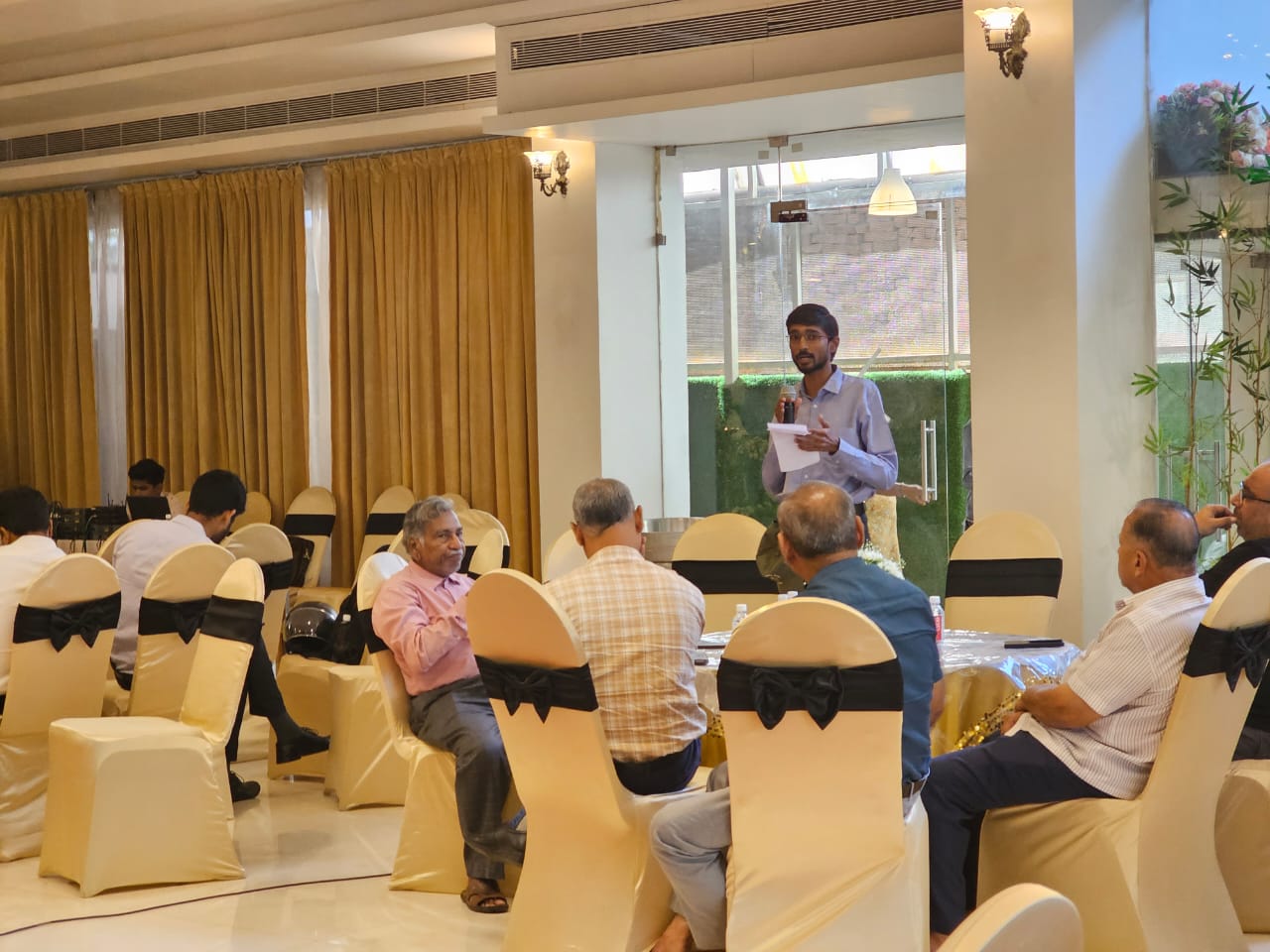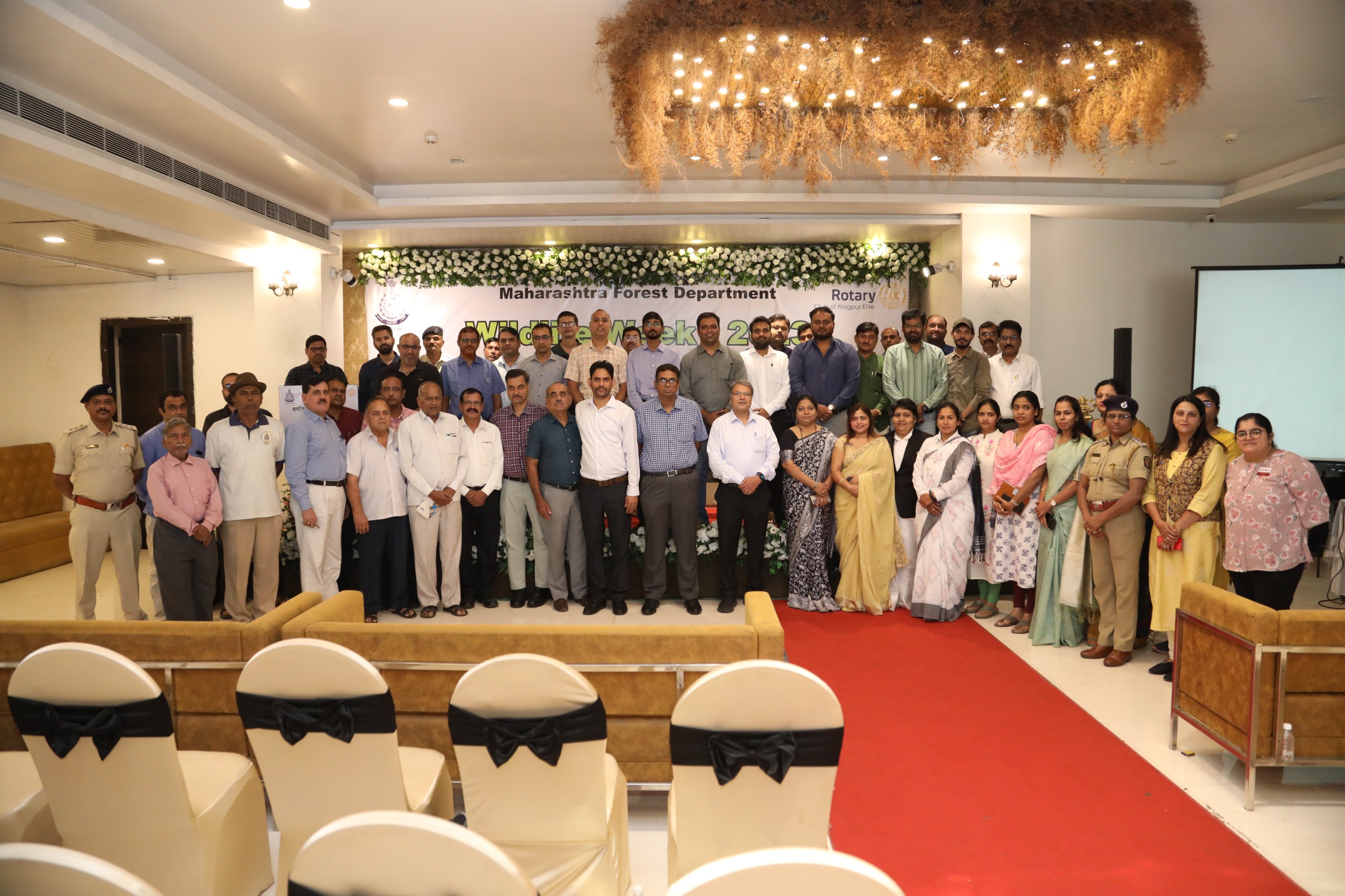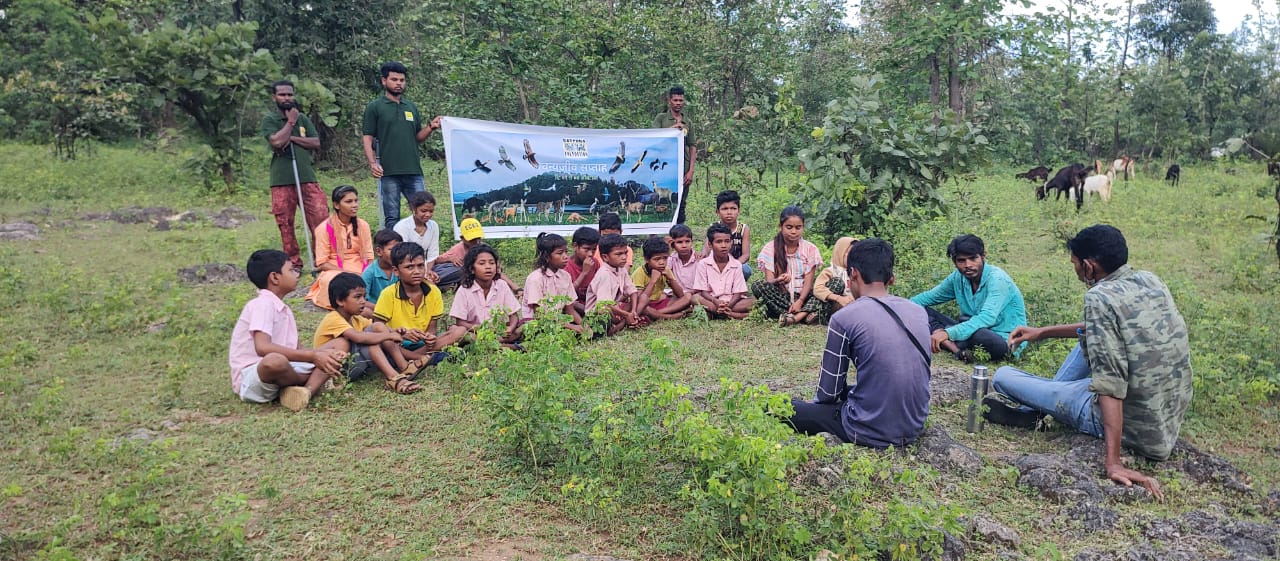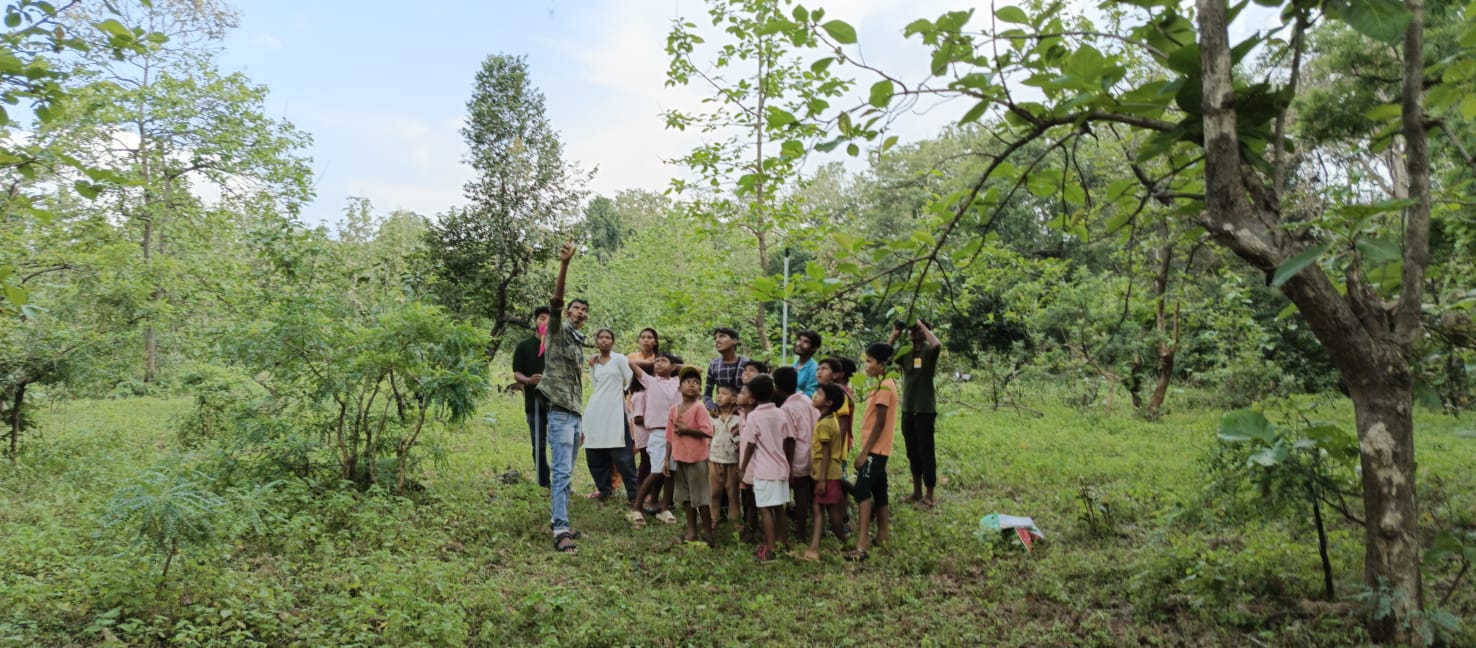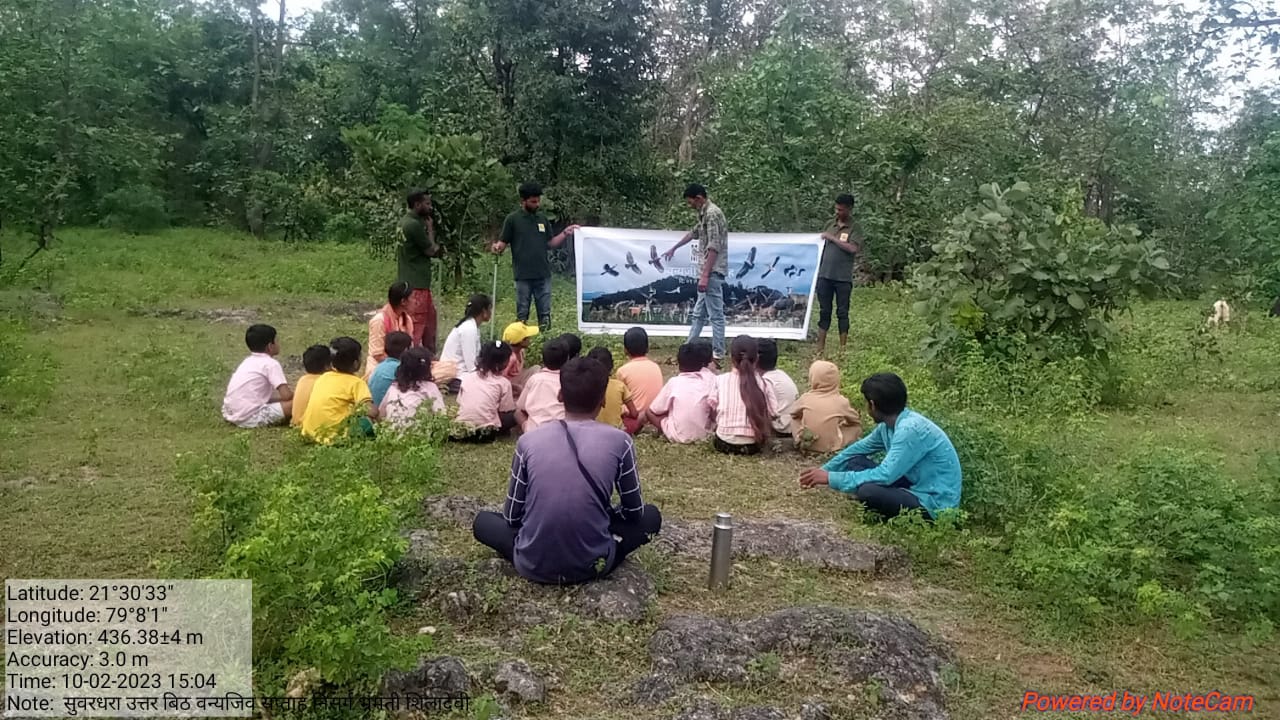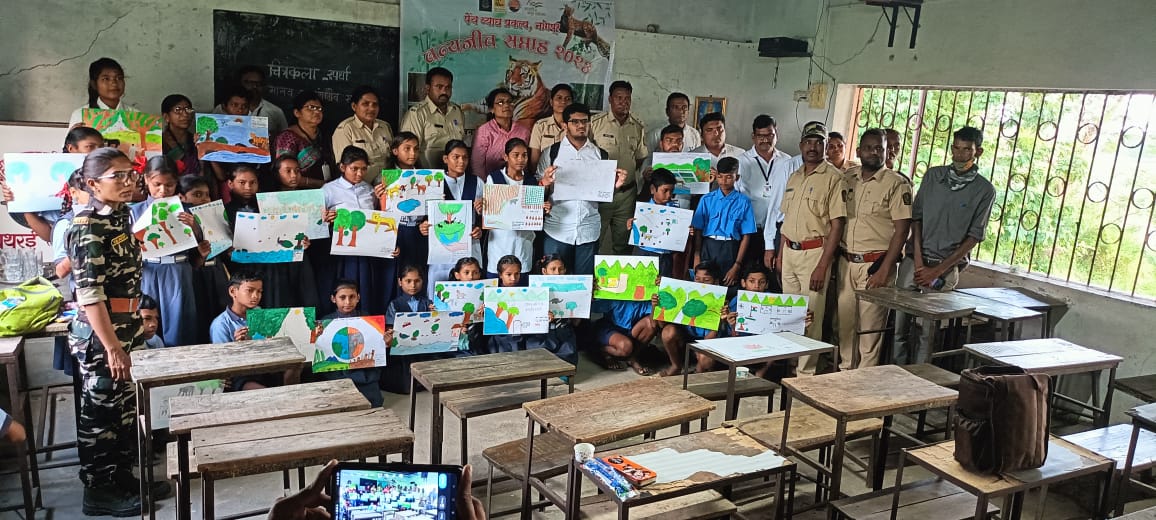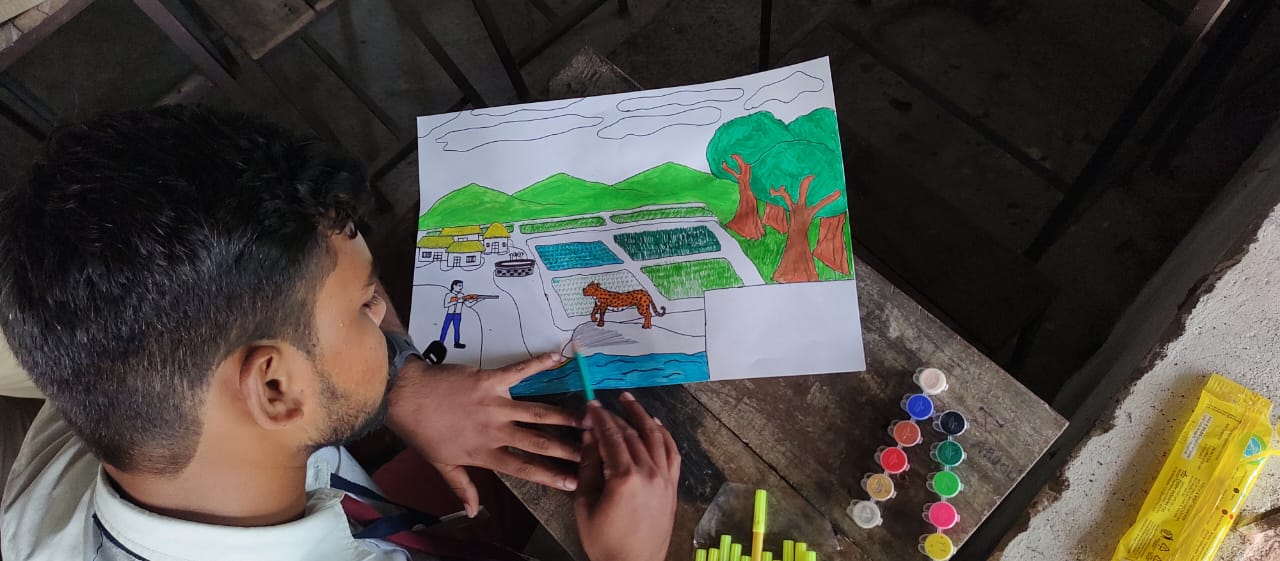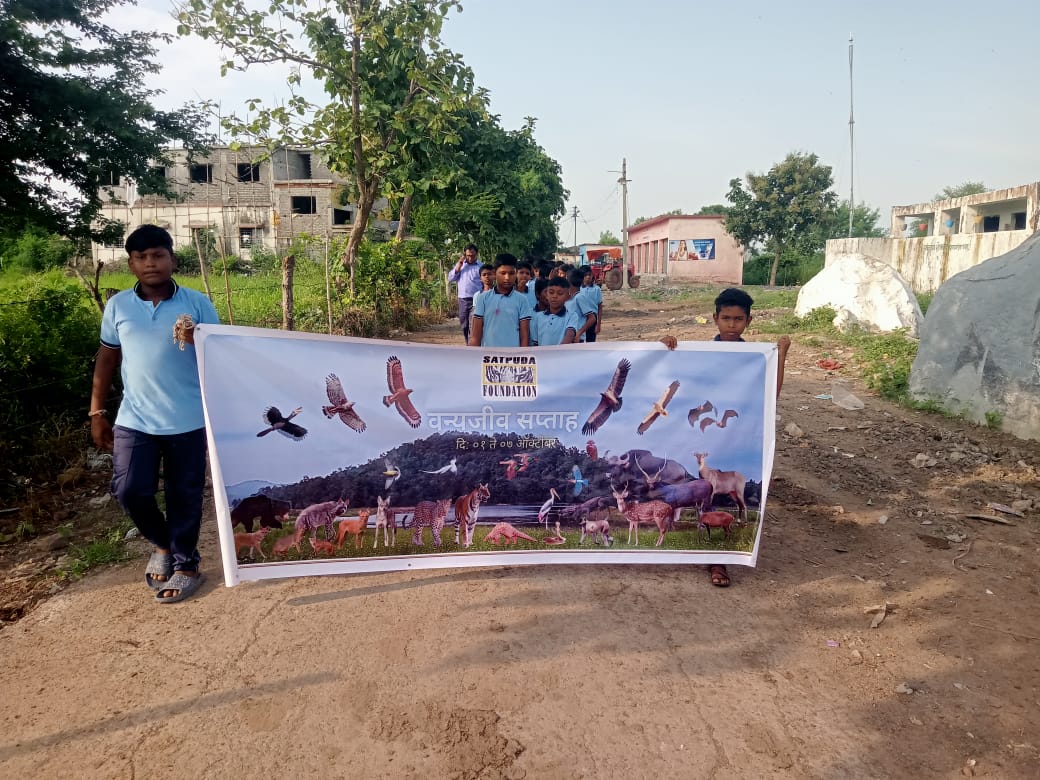News 2025
Satpuda Foundation successfully conducted the Naturalist Training Program
Updated: February 18, 2025
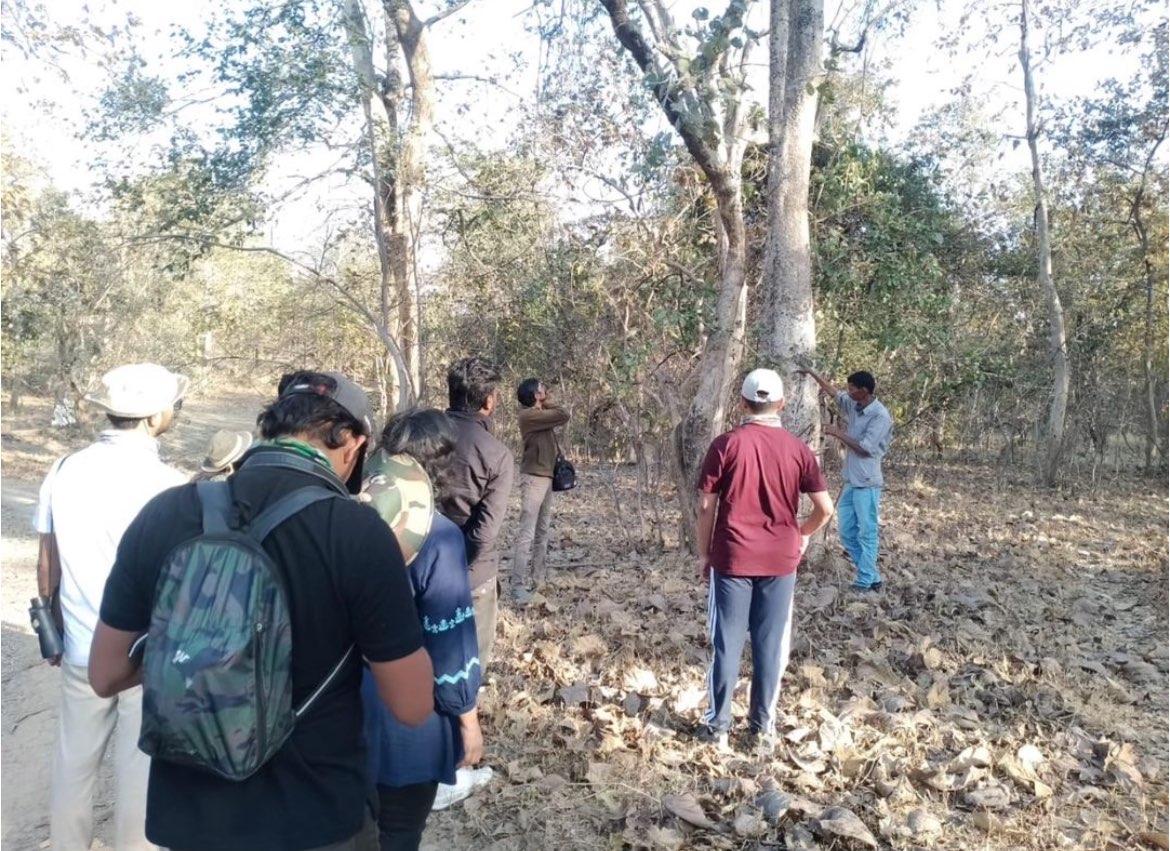
Satpuda Foundation successfully conducted the Naturalist Training Program at Saila Community Resource, Wildlife Research & Education Center, Pench (Maharashtra) from 14-16 Feb 2025. Participants from Madhya Pradesh and Maharashtra, representing diverse backgrounds, explored Central Indian biodiversity through interactive sessions, nature trails, jungle safaris (Sillari & Chorbahuli), and a visit to Kolitmara Tourism Complex. A special session on spiders and reptiles broadened perspectives beyond the tiger. Engaging discussions over a bonfire made the experience even more enriching. A big thank you to all participants for their enthusiasm and commitment to conservation!
Click on the link below to visit the official Instagram page and stay updated:
https://www.instagram.com/p/DGM0oLES5Em/?igsh=cnM4MDVjY3lnbnl1
News 2024
Satpuda Foundation Executive Director Giri Venkatesan dies aged 62
Updated:June 25, 2024

Venkatesan was instrumental in spreading the work of Satpuda Foundation in the buffer villages of the tiger reserves like Pench, Navegaon Nagzira, Tadoba, Satpuda Tiger Reserve Pachmarhi, Kanha Tiger Reserve Madhya Pradesh, among others.
His last rites will be performed at Badrinath itself, family sources said.
Giri Venkatesan (62) worked for English media outlets for almost 25 years. He then became acquainted with the work of wildlife lover Kishore Rithe and his organization Satpuda Foundation.
Rithe is now Director of Bombay Natural History Society (BNHS).
Venkatesan was fascinated by the forests of Melghat and Pench.
In 2007, he resigned from his job and joined Satpuda Foundation without accepting any remuneration.
He started working at the grassroots level. He started the Employment Cell in 2010 for the economic development of the villagers. He provided employment to about 2,000-3,000 youth by conducting several training programmes to train drivers, guides, security guards, and sessions on how to run small scale businesses.
He was later appointed executive Director of the Satpuda Foundation. He served in this position from 2010 till his demise.
He was instrumental in spreading the work of Satpuda Foundation in the buffer villages of the tiger reserves like Pench, Navegaon Nagzira, Tadoba, Satpuda Tiger Reserve Pachmarhi, Kanha Tiger Reserve Madhya Pradesh, among others. He was instrumental in setting up the SF’s research centre near Sillari village in Pench.
"Despite his vast media experience, he conveniently distanced himself from the limelight while doing all this work. He had a reputation for being very hardworking and punctual and disciplined. Due to his experience at the national level as well as internationally, he brought administrative discipline to Satpuda Foundation and also set up several systems within the organisation," said Rithe.
‘Parabraksh’ comes as a hope for farmers facing animal conflict
Updated:June 20, 2024

Nagpur: At a time when lakhs of farmers are facing huge financial losses due to crop damage and cattle-killing by wild animals in forest landscapes, a Bengaluru-based start-up has come up with ‘Parabraksh’, a solar-powered smart animal deterrent technology, which hopes to ensure an ideal future of harmonious human-wildlife coexistence.
‘Parabraksh’ means protection from wild animals in Kannada.
The technology uses strategically-placed LED flashlights to mimic predators’ eyes and create randomized lighting patterns, thereby scaring away animals like tigers, leopards, elephants, deer, wild boars, nilgais, foxes, and others, ‘humanely’. This autonomous device operates at night and charges with solar panels. It can also be used with the help of mobile chargers.
Till now over 2,000 units have been supplied to 1,600 farmers in 12 states, most of them in Pench, Tadoba reserves and other districts of Maharashtra. Each unit, costing over ₹10,000, consists of a six-watt solar panel, lithium-ion battery, and 4 LED lights.
“The ground impact of this device has been quite phenomenal. The solar-powered lights emit random patterns visible up to 250 metres and deter predators from encroaching into human habitats,” claims Ayan Katidhan, start-up founder and innovator of the device.
Deputy director of Satpuda Foundation Mandar Pingle informed that 34 ‘Parabraksh’ units were provided free of cost to 30 farmers in Sillari (Pench) with support from Lions Club of Mulund. “Only three farmers claimed minor compensation for crop losses. Additionally, Satpuda Foundation distributed 400 units across multiple villages in Pench’s buffer area,” said Pingle.
“A spot survey in 2023 in Sitarampeth and Junona outside Tadoba, where these units were supplied in 2022, revealed that approximately 89% of farmers expressed a desire to implement ‘Parabraksh’ units for crop protection, although affordability emerged as a recurring concern,” said Pingle.
Katidhan says, “If bought in bulk, the unit can even cost ₹7,000 each.”
One of the beneficiaries Vijay Meshram, of Junona, said, “One night, two Parabraksh lights were switched off, and a leopard entered the village from that direction and killed a dog.”
Prakash Kodwate, a farmer from Sillari (Pench), said, “After installing ‘Parabraksh’, crop depredation by wild boars has reduced.”
In a first, Peacock Royal butterfly caught on camera in Maharashtra's Pench Tiger Reserve
Updated:May 31, 2024

Mumbai: The Peacock Royal butterfly (Tajuria cippus) has been captured on camera for the first time inside the Pench Tiger Reserve in Ramtek in Nagpur district of Maharashtra.
Four to five specimens were sighted on a Banyan tree at Mama Tower, located at an elevation of 438 meters above sea level, on 23 May 2024 at 4:00 pm. “This observation marks the first recorded occurrence of this species in the Pench Tiger Reserve,” said Mandar Pingle, Deputy Director, Satpuda Foundation.
Tajuria cippus, commonly known as the Peacock Royal, is a lycaenid butterfly widely distributed across Asia. It typically inhabits forested regions and is indicative of healthy ecosystem diversity. The species’ range in India has been documented in various works but records from Maharashtra are sparse.
This report adds to the knowledge of its distribution, specifically within Pench Tiger Reserve.
“The observation was incidental, made during a site visit for a camera installation project in Pench Tiger Reserve, rather than during a focused butterfly survey. The location, Mama Tower, has good flora diversity, including large Banyan trees (Ficus benghalensis) that provide a habitat for various butterfly species. The elevation of the site is 438 meters above sea level. Standard butterfly observation protocols were followed post-observation, including visual identification and photographic documentation,” said Pingle.
According to him, this observation represents a significant range extension for Tajuria cippus within Maharashtra.
“Previously, the distribution of this species in the state was not well-documented. The sighting at Pench Tiger Reserve suggests that the reserve’s diverse flora supports this species. This finding highlights the reserve’s role in conserving regional biodiversity and underscores the need for continued biological surveys,” he added.
News 2023
PROGRAM ORGANISED TO CELEBRATE WILDLIFE WEEK 2023
Updated:Oct 3, 2023
Mr. Mandar Pingle represented Satpuda Foundation during a panel discussion session intended to address the human-wildlife conflicts. The program was organised by Maharashtra State forest department to celebrate Wildlife Week 2023.
Nature Trail event was organized for students in the Shiladevi village of Nagalwadi range
Updated:Oct 2, 2023
On the occasion of Wildlife Week 2023, a Nature Trail event was organized for students in the Shiladevi village of Nagalwadi range. During this Nature Trail, students had the opportunity to explore the nearby forest, observe various wild animals and birds up close, and learn from experts like Bandu, who provided guidance on identifying and understanding wildlife. They spotted birds like hornbill, drongo, parakeets, babblers, and kingfisher, among others, while Bandu shared valuable information about their natural behaviors and importance.The event was attended by committee president Mr. Arun Naikam, committee members Sunil Tumdam, Sankilal Uikey, Mukesh Kumare, and 32 students.
Furthermore, a cleanliness campaign was conducted in Ghoti village, aiming to raise awareness about cleanliness and remove plastic and waste from the roadsides. The campaign encouraged the villagers to maintain cleanliness in their surroundings.During the program, forest officer Mr. Rajurkar, Dinesh Dhurve from the Satpuda Foundation, Deputy Chairman of the Committee Mr. Dilip Lanjewar, committee members, and villagers discussed strategies to mitigate crop damage caused by wildlife. They also visited affected farms to assess the situation and plan preventive measures.
Maharashtra's Pench Tiger Reserve to turn greener by going completely solar
Updated:May 8, 2023

NAGPUR: Pench Tiger Reserve (PTR) Maharashtra, will completely do away with electricity soon by implementing a Rs2.50 crore project to run the ecotourism complexes, water holes, camp offices, guest houses, and staff quarters exclusively on solar energy.
Pench conservator of forest (CF) & field director A Sreelakshmi said, “The project is being implemented by Maharashtra Energy Development Agency (MEDA), a state government institute regulating energy conservation. We had submitted a proposal to the agency, which did a survey and is now implementing all the works. We expect the project to be completed in a couple of months.”
Out of Rs2.50 crore cost, approximately Rs86 lakh was received from the District Planning Development Council (DPDC) last year, and sanction for another Rs50 lakh has been received.
Apart from this, over Rs50 lakh has been spent on making borewells, which have solar-powered pumps under the corporate social responsibility (CSR) by ICICI Foundation.
Pench deputy director Prabhu Nath Shukla said, “The project will not only save around Rs15 lakh towards energy bills annually, but will also reduce carbon emissions. We will be the first reserve to entirely operate our utilities on solar now.”
Around 147 KW of energy has been sanctioned to connect campuses, offices, and residential quarters to the grid. The four ecotourism complexes have at least 40 rooms for tourists in Amaltas (Sillari), and the ones at Surewani (Nagalwadi), and Kolitmara (West Pench).
“There are at least 150 water holes in Pench buffer and core zone that are solar powered. Of these, work on 55 solar borewells was done by ICICI Foundation last year under CSR. Besides, all 65 protection huts in the reserve are also solar-powered,” Shukla said.
Shukla added, “We have six rest houses, seven range houses, and canteens at Sillari, Kolitmara, Surewani, and Khudsapar. All of them will now run on solar. To ensure that the project runs without any hassles, an annual maintenance contract (AMC) will also be given.”
MEDA regional director Vaibhav Pathode said, “Under the DPDC funds, solar lights and high masts will also be installed. Some of the utilities of the tiger reserves will be on-grid while others off-grid.”
Deputy director of Satpuda Foundation Mandar Pingle welcomed the move, “By taking to renewable energy, the tiger reserve is setting an example for others. Several villages in Pench buffer can replicate such interventions.”
“Solar light reduces the problem of distribution in the power supply due to tree fall due to wind or other factors. Besides, it enhances the value and standard of ecotourism sites. It avoids criss-cross web of electric lines from the campus, and is better placed from the safety point of view. If maintained at regular intervals, their life is long,” says Sreelakshmi.
In buffer villages too solar lights are being distributed under Dr Shyama Prasad Mukherjee Scheme. It is reducing the accidental encounter of wild animals with villagers. ICICI Foundation is also providing solar lights in school campuses of buffer villages.
“Pench has inventoried all solar systems distributed in the past, including those given in villages. It has made a plan to make functional all installations that are not working due to any reason,” said Shukla.
Wildlife conservationists say even as Pench helps MPEB produce hydroelectric power, which is considered green, the tiger reserve has to pay for solar energy.
However, Pench officials said, “As per the agreement between the two states, the water is used by Maharashtra and power by Madhya Pradesh. We get electricity from MSEDCL,” he said.
Nagpur: Wildlife board meeting ends in 5 minutes, clears all project barring 2 national highways
Updated:May 3, 2023

NAGPUR: The State Board for Wildlife (SBWL) stooped to a new Tuesday with its 20th meeting ending in just five minutes, clearing all the linear projects affecting protected areas ( PAs), Eco-Sensitive Zones (ESZs) and tiger corridors without any discussions.
There were no discussions on detrimental proposals like the proposed Guguldoh manganese mine, and airport at Rajura tehsil, both falling in the tiger corridor of Pench-Navegaon-Nagzira and Tadoba-Kawal tiger reserves respectively,” said sources who attended the meeting.
“The agenda was cleared by forest minister Sudhir Mungantiwar who attended via video conference from Nagpur, while SBWL chairman chief minister Eknath Shinde was away attending back-to-back meetings. When he came to attend the meeting, the entire agenda list, barring two highway projects in Chandrapur district, had been approved,” they said
Sources said the meeting was slated for 1pm at the CMO, but since chief minister Eknath Shinde was busy attending other meetings, it was held at 2.45pm.
Asked authorities to impose Rs 20.8 crore penalty on Central Railway
By the time State Board for Wildlife (SBWL) chairman CM Eknath Shinde entered the meeting hall, Sudhir Mungantiwar, vice-chairman of the board, had already cleared the agenda without presentations or discussions. Mungantiwar told TOI, "The meeting lasted for 15 minutes and all the members had already gone through the draft agenda items. As most of the agenda items were about laying of optical fibre cables discussions were not held." Eight OFC projects that were cleared belong to Reliance.
"We've also asked the authorities to impose a penalty of ₹20.81 crore against Central Railway for starting work in Great Indian Bustard Sanctuary without nod," he said.
The forest department had recommended a penalty of 1% of the project cost of ₹20.81 crore for work in 247km. The railway agency has urged to reconsider the penalty by imposing 1% (₹6.70 lakh) of the project cost in 800 running meters, where violations were done.
Mungantiwar said the meeting also approved airport project at Murti-Vihirgaon in Rajura tehsil. On Guguldoh mine block in Pench-NNTR corridor, he added, "If the project is part of the functional tiger corridor, we will have to review it." Guguldoh project, which needs 100 hectares of dense forest in the tiger corridor, was recommended by Shiv Sena MP from Ramtek Krupal Tumane. Its mitigation plan has been prepared by none other than the Chandrapur Forest Academy.
Kishor Rithe, secretary and interim director of BNHS, which is a member of SBWL, said, "We have provided our views on the agenda in writing to the PCCF (wildlife) and have requested him to put them on record."
Environmentalist Debi Goenka said, "For the first time in Maharashtra, meeting of the improperly constituted wildlife board ended in 5 minutes. There was no discussion and no presentations." "Agenda papers were not circulated to NGO members in advance, and almost all projects on the agenda, including those in critical wildlife corridors in Vidarbha were cleared. It seems this is the strategy formulated by our forest minister to reduce the tiger population in Central India to reduce man-animal conflicts," Goenka said.
News 2022
Rally for awareness of Wildlife Conservation
Updated:Oct 4, 2022

On 4th October, an awareness rally was organised by Moharli range office, Satpuda Foundation and guide and gypsy association of Moharli gate to mark wildlife week.
65 gypsys, 45 guides and entire staff of Moharli core and buffer were took part in the rally.
The rally passed through Moharli, Bhamdeli, Sitarampeth, Kondegaon and Mudholi villages raising awareness about wildlife conservation and human wildlife conflict mitigation.
Satpuda Foundation's banners for management of human-wildlife conflicts were put up on the gypsy. The rally stopped in the middle of these villages and slogans raised by participants to create awareness and garner community support for wildlife conservation.
Conservation of lesser-known species will be BNHS's priority
Vijay Pinjarkar / TNN / Aug 21, 2022, 04:03 IST
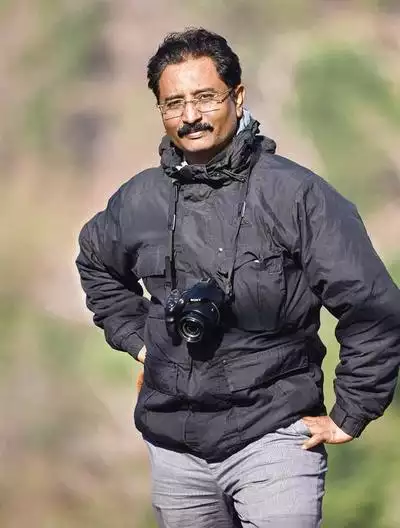
City's Kishor Rithe (50), founder of Satpuda Foundation, an NGO working in Central India for the last three decades for tiger and wildlife conservation, has been elected as the honorary secretary of one of the the country's largest NGO, Bombay Natural History Society (BNHS), founded on September 15, 1883, in Mumbai. Ornithologist Salim Ali was associated with BNHS.
Rithe took over as secretary last month, and this is for the first time a wildlife expert and conservationist from Vidarbha has been elected to the coveted post. His appointment assumes significance as BNHS is an independent research-based conservation organization closely working with state governments and the ministry of environment, forests and climate change (MoEFCC).
Rithe is also a member of various panels and state wildlife boards. BNHS strives to conserve nature through research, conservation, education and public awareness. Rithe's vast experience is will certainly benefit the NGO. TOI talked to Rithe about his BNHS agenda for forest and wildlife conservation.
Excerpts from an interview...
Q. What does your role entail?
A. BNHS is the country's premier scientific organization and every wildlife biologist and conservationist feels proud of it. Several people from Vidarbha are associated with BNHS. It always caught my attention and I became a member in my college days. I learnt more about the leading NGO when I was an executive committee member in 2004. As an executive committee member, I started BNHS operations in Central India in 2004 through the Satpuda Landscape Tiger Programme (SLTP). Since then, I have continued my association with the NGO. In the last decade, The structure of BNHS has been changed and proper representation has been given in the governing council to all the states and regions of our country. This paved my way to becoming the honorary secretary of this prestigious organization. The secretary's role main responsibility is to mobilize support from members and well-wishers and transform it for research-based conservation activities.
Q. How are you doubling up as a conservationist and secretary?
A. I've always been a man from the field working with local communities. Even when I'm working on several policies and decision-making bodies like the state biodiversity board, SBWL, standing committee of NBWL, Supreme Court and high court committees, I continue with my grass-root level initiatives and associations. That gives me opportunities to meet like-minded academics, youths, NGOs, community leaders, forest staff, government officers, reporters and judicial officers. This network of green crusaders helps me to deliver as secretary of BNHS.
Q. What kind of changes do you wish to bring about at BNHS?
A. At BNHS, we are fortunate to have Bivash Pandav, an experienced and dynamic director, young governing council members from every corner of the country and dedicated field staff with 24x7 office support from Hornbill House. We have got a better understanding of the issues and a good team spirit among the office-bearers as well as the staff. Our predecessors have already set the stage for us. Several IFS and IAS officers are raising their expectations. Members of BNHS are our backbone to execute the initiatives in the remotest areas of the Indian landscapes. just channelizing these expectations of the stakeholders with BNHS teams. I'm trying hard to meet their growing expectations for the conservation of our country's neglected landscapes and species.
Q. Vidarbha has 90% of the state's tiger population. In what way does BNHS plan to deal with human-animal conflict?
A. BNHS has been doing wonderful work in Vidarbha since 2004. We are working in tiger corridors which is a tough challenge right now. Our team is working with local communities to reduce tiger attacks on humans and livestock. Apart from tiger conservation, we also want to deploy our teams for studying and conserving Sarus cranes, GIBs, lesser floricans and many other lesser-known species. We will soon initiate activities with support from the forest department as per the directives of the Nagpur bench of Bombay High Court. Local NGOs in Vidarbha have great potential and at the same time faith in BNHS and we would love to coordinate with them and support and strengthen them. You will see some efforts in this direction in the next two years.
Q. BNHS is known more for scientific research, publications, holding nature camps, etc. Is there a need to look beyond?
A. Yes, we need to change this perception. BNHS is a scientific organization but is also active in taking research-based conservation initiatives. Our scientists have many conservation accomplishments to share with the world. The initiatives taken for vulture conservation, Indian skimmer, flamingoes and GIBs are good examples. Earlier, we were shy about sharing our success stories. But now, our director and governing council have decided to share all the positive outcomes from the field on a regular basis.
Q. BNHS is more focused on conservation of birds. Any plans to bring back endangered species like GIBs, lesser floricans and vultures facing extinction?
A. Yes, our young scientist Sujit Narawade and his team are working hard in Gujarat and Rajasthan to address the emerging conservation issues. We've achieved great success in raising the vulture population through ex-situ conservation under the leadership of senior scientist Vibhu Prakash. We are also grateful to MoEF&CC, CZA, state governments, Royal Society for Protection of Birds (RSPB) and Birdlife International for their support. BNHS has already identified safe zones in the country where we can release these vultures and monitor them post-release. But there are many such species like the Indian skimmer that are facing a similar threat. Our scientist, Parveen Shaikh, is working in Chambal for its conservation with the support of local communities and the MP forest department. These plans will certainly bring good news for India.
Q. Are there any plans to support start-up NGOs working for conservation?
A. Yes, we do not want to become a giant organization working alone. The BNHS president and governing council have suggested working with local NGOs, passionate individuals and BNHS members in every important landscape. There are plans to establish these links through collaborative programmes.
Q. What kind of future do you envisage for wildlife conservation?
A. The MoEF&CC and a few state governments have expressed their desire to work for conservation of lesser-known species. We have a strong will, passion and dedication coupled with the past scientific data. BNHS is probably the only organization in India with vast scientific data. Climate change has posed several problems for these species and in the near future, you will see BNHS projects addressing them in many landscapes in the country.
Q. Is there any flagship project which is getting global attention?
A. Our central Asian Bird Flyway programme run by P Sathiyaselvam, head, Wetlands & Flyway, is one of the flagship programmes to study the migratory routes of waterbirds wintering in India. Our scientists are ringing thousands of birds at several places in India like Pulicat and Kolleru, Gujarat, Maharashtra, Kerala and Telangana. We have already re-sighted a few ringed birds in Russia and places within the country. This gives us lots of information on bird migration. Similarly, our scientists are also doing satellite tracking of birds and this year, flamingoes tagged in Mumbai were tracked to places in Gujarat. This will reveal many more mysteries. BNHS has a collection of over 1.40 lakh specimens from different parts of the country. We are digitizing the same so that we can make this information available to a few Indian universities.
World Health Day: Over 2 lakh villagers living in tiger reserve fringes treated by Satpuda Foundation
Vijay Pinjarkar / Updated: Apr 7, 2022, 22:17 IST

Nagpur:Satpuda Foundation , an NGO working for the past two decades for wildlife conservation, socio-economic development, and providing primary healthcare facilities to the communities in the central Indian landscape, celebrated "World Health Day 2022" in Chargaon.
The village is in the buffer area of Pench Tiger Reserve (PTR), Maharashtra. In the last two decades, the NGO has treated more than 2 lakh villagers living on the fringes of tiger reserves in the region.
As part of the celebration, Satpuda Foundation organized an awareness session in zilla parishad primary school of the village for students and village elders. Over 42 students in the age group of 10-14 years and 30 senior citizens including members of women self-help groups (SHGs), youths, gram panchayat members and members of the village eco-development committee were present.
Dr Kshipra Tumdam, community health officer, primary health centre, Navegaon-Khairi, was the chief guest. Dr Tumdam sensitized the villagers regarding various health issues faced by the community.
Dr Tumdam spoke about the lack of general hygiene in the rural areas as a major concern for community health and explained to the villagers that due to lack of hygiene, many contagious diseases can spread.
She called for maintaining proper hygiene within the home and community and focused on the issues of women and child health while interacting with the members of women's self-help groups.
Dr Tumdam explained to villagers about various government schemes and free healthcare facilities like the Ayushman Bharat Pradhan Mantri Jan Arogya Yojana and Mahatma Jyotiba Phule Jan Arogya Yojana.
Bandu Uikey, assistant conservation officer, Satpuda Foundation, explained that the theme for this year is 'Our Planet, Our Health'. Elaborating on the theme, Uikey explained to the village elders and the school students that in the past few decades, due to population explosion and thereby increasing human demands, there has been huge anthropogenic pressure on the natural resources.
"Destruction of wildlife habitats for agriculture, industries, transport projects, mining of minerals and coal, and exploitation of water sources have caused serious human health issues. Not only human health but also the health of wildlife is affected by such unsustainable practices. In order to lead a healthy life we need to keep the health of our planet in good shape, " Bandu explained.
"Satpuda Foundation has been regularly providing free-of-cost primary healthcare services to the communities living on the fringes of forests in central India for the past two decades now. These communities are most vulnerable to any health issues that might arise due to climate change and degrading wildlife habitats, " said Mandar Pingle, assistant director, Satpuda Foundation.
Kishor Rithe, founder, Satpuda Foundation, said that in the past two decades, around two lakh villagers of buffer areas of Pench, Nagzira, Satpura, Melghat, and Tadoba-Andhari tiger reserves were treated during their medical camps.
"For many villagers living in remote places, our mobile health unit is often the main source of a healthcare facility. By providing this assistance to villagers, we have been able to win their trust and have motivated them to help protect the wildlife and forests, " Rithe said.
"This trust-building activity has helped Satpuda Foundation in drawing conservation actions from the local community. Every health camp takes us closer to the hearts of the patients who also share information like their cattle loss or injury or crop losses by wildlife. Our staff tries to address such issues with the help of the forest department and prevent retaliation by the community towards wildlife, " Rithe said.
Student of Zilla Parishad Upper Primary school set-up water pots for birds
Updated: April 5, 2022
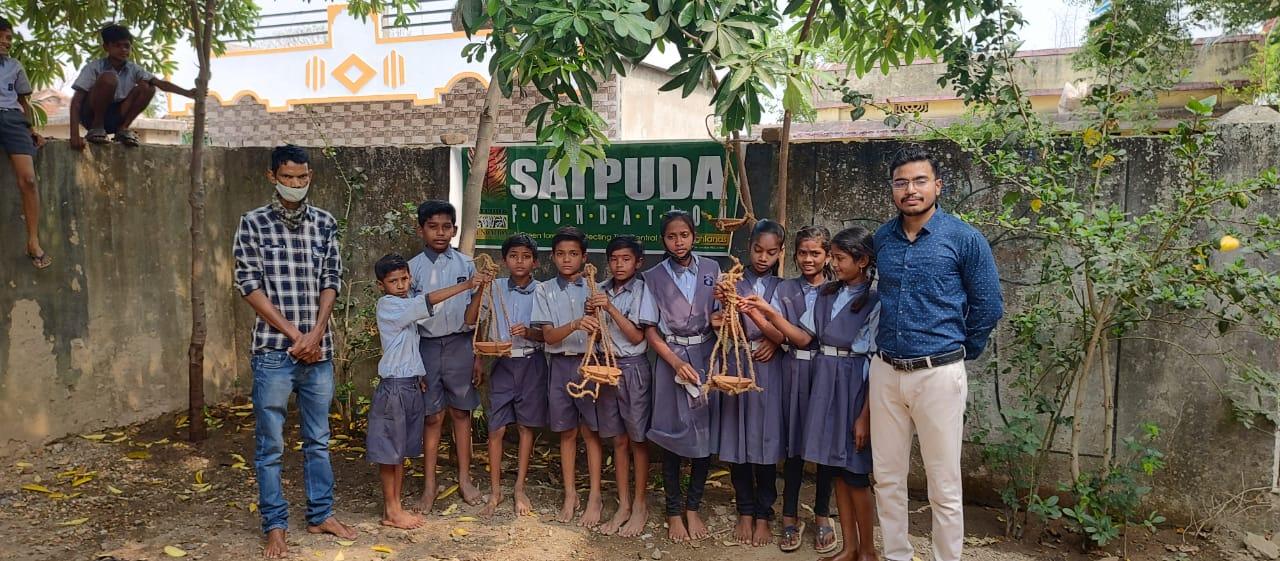
Place: Chargaon (Pench Maharashtra)
Student of Zilla Parishad Upper Primary school of Chargaon village set-up water pots for birds. Under the guidance of Satpuda Foundation's Assistant Conservation Officer, Bandu Uikey, the students placed water pots at various locations within their school campus. The students ensured that the water pots were placed in cool shades so that it will help provide respite to birds from scorching summer heat. "Bandu sir told us that birds help to keep a tab on crop pests and are our friends. So it is my responsibility to help my feathered friends", quipped one of the students while tying a water pot to a tree branch.
First in country: A flyover for animals on Mumbai-Nagpur highway
Vijay Pinjarkar / TNN / Updated: Feb 23, 2022, 09:14 IST

NAGPUR: The Balasaheb Thackeray Samruddhi Mahamarg (expressway) between Nagpur and Mumbai will be the first highway in the country where nine green bridges (overpasses) and 17 underpasses for wild animal movement are being constructed as part of mitigation measures.
Also, all along the highway, leopard-proof fences will also be constructed so that the animal doesn't jump over on to the 701 km expressway which will see vehicles plying at speed up to 150kmph. The 120-metre wide road runs through 10 districts of Maharashtra and will cut the travel time from 16 to 8 hours.
Of this 701km, 117km passes through wildlife habitats, tiger corridors, and eco-sensitive zone (ESZ) of three sanctuaries - Tansa, (corridor of Harishchandragadh sanctuary), Katepurna, and Karanja Sohol called as wildlife-focused area (WFA).Hence, the forest department insisted on mitigation steps to prevent animal deaths in road hits.
Overall, there will be 1, 797 structures including box culverts, minor bridges, culverts, canals, viaducts, cart tracks, vehicle overpasses (VOPs), minor and major bridges, tunnels etc.
Bilal Habib, the scientist with Wildlife Institute of India (WII), Dehradun, who planned the wildlife structures, said, "Apart from these other structures, there will be 7 eco bridges in WFA and 2 outside WFA. Besides, there will be 17 wildlife underpasses in WFA and 25 outside WFA."
Talking to TOI, RL Mopalwar, managing director of MSRDC, the agency executing the project, said, "This is for the first time in the country that any highway will have so many wildlife structures and green bridges.We have agreed to most of the modifications recommended by an expert committee."

"These green bridges are under construction and work is going on at a fast pace. Some structures have also been completed.Most of these structures are 32, 45, and 60 metres wide and 120 metres long.hese will have plantations and will look like a natural forest path to allow animals to cross safely even as traffic will pass under it. These will also have noise barriers so that animals don't feel threatened, " said Mopalwar.
Kishor Rithe, state wildlife board (SWBL) member and who was also on the expert panel of Samruddhi, said, "The project is divided into 16 packages and we have ensured that every bit of the structures like culverts, were designed in a manner that would benefit wildlife and even small mammals like civet cats, reptiles, pangolins, etc."
"The DPR had included few wildlife mitigation measures which were modified by the WII after collecting a wildlife presence data through a study. The expert committee had made the site inspection in February and March 2020 to see and understand the WII modified proposed mitigation structures. We had suggested changes to some of the wildlife underpasses and overpasses and also to proposed box culverts, bridges, and viaducts considering some important aspects previously ignored. Knowing well that many such linear infrastructure projects will be planned in near future, the understanding generated by this project will be vital to find a win-win solution for both wildlife and the economy, " says Rithe, one of the expert members.
"It is true that so many green bridges would be a new development and will help wildlife movement immensely. At a time when tigers hog all the limelight, we thought of chinkaras too, and in the dry land habitats, three overpasses of 32, 45, and 60-metre-width and 120-metre-long overpasses will be built. In the eco-sensitive zone (ESZ) of Katepurna sanctuary, one 16-metre-wide 120-meter-long eco-bridge will be constructed, " said Rithe.
These eco-bridges are being built in the ESZ of wildlife sanctuaries through which the Samruddhi Expressway passes. Earlier, long underpasses were constructed on NH7's Pench-Kanha corridor between Nagapur and Jabalpur.
WII's Habib says, "Wildlife underpasses are equally important for animal movement. While constructing the Samruddhi Expressway, there were several hillocks that had to be cut for road work.Animals also use these hillocks to move. So, to ensure that their connectivity doesn't break, we suggested green bridges as well as underpasses. Once constructed, the animals will be able to cross over to the other side over moving traffic."
Suresh Chopne, of the Regional Environment Committee (REC), MoEFCC, who recently visited the site on Nagpur-Wardha-Pulgaon said, "It is a unique project in the country. These green bridges are needed for the future to save wildlife. Though not common in the country, these are important as they allow connection and reconnection between habitats.These green bridges can be used by carnivores as well as herbivores and even mammals. The structures will help avoid vehicle-animal collisions."
MSRDC executive engineer Bhushan Malkhandale said, "Mitigation measures are being taken seriously. This can be gauged from the fact that in my 58km section between Wardha-Nagpur, there are 29 wildlife underpasses and a couple of overpasses. In Bor and Tadoba tiger reserve corridor, a 300-metre underpass is being constructed for tigers."
Wildlife expert slams WCL, CSTPS for human deaths
Vijay Pinjarkar / TNN / Feb 19, 2022, 04:37 IST
Nagpur: Two human deaths in 24 hours - one at the Chandrapur Super Thermal Power Station (CSTPS) and another in Western Coalfields Limited's (WCL) Durgapur premises in Chandrapur - have shaken up wildlife experts, who had raised concerns over preventive steps not being taken.
On Thursday, a tiger mauled contractual worker Bhojraj Meshram at CSTPS, and late in the night, a leopard killed 16-year-old Raj Bhadke near the Durgapur gram panchayat office.
Wildlife expert Kishor Rithe, who is a member of the State Board for Wildlife (SBWL) and founder of Satpuda Foundation, said the two death could have been avoided. He slammed CSTPS as well as WCL for non-compliance. Rithe said the issue was already discussed at length in the SBWL meeting held in Mumbai on December 5, 2018, and WCL was asked to make its area wildlif -unfriendly by removing lantana camara and prosopis juliflora.
The then forest minister had gone to the extent of saying that if WCL did not do it within time, the forest department should do it. "However, nothing much has been done on making it unfriendly for widlife habitat. The same issue was raised again in the SBWL meeting on August 7, 2020, about the CSTPS and WCL area, " Rithe said.
He added, "I had pointed out that both these agencies must act on a war footing and remove the weeds and shrubs, and take the area under their possession. But a section of officers in WCL and CTPS mounted pressure on the forest department to shift the tigers rather than making their campus wildlife-unfriendly."
Rithe said the problem was not going to be solved on a permanent basis by just shifting a few tigers from the area. "This will be a short-term solution. WCL and CSTPS need to take long-term solution. The two human deaths could have been avoided had these agencies acted in time, " he added
CSTPS has more than 11, 000 hectares area under its possession and making such a big area wildlife-unfriendly is a herculean task, but not impossible, if done systematically as per experts' advice The prosopis can be removed successfully only when you understand the other parameters.
"But I have not heard of any such technical effort taken by by the two agencies. Every time some unfortunate incident happens, WCL and CSTPS officials look at the forest department towards shifting tigers.This is not expected from such responsible agencies. They must consult experts and prepare an action plan and execute it in a time-bound manner.If not, both agencies should be held responsible for the mess, " said Rithe.
Carrying out some cosmetic changes like road construction and erecting CCTV cameras won't ensure the safety of residents and workers in their premises, he further said. "These two agencies have a huge area under their possession, which is close to Tadoba Andhari Tiger Reserve and the densely-populated Chandrapur. If they do not act, they will be taking the problem to the doorstep of citizens, " Rithe warned.
Stalled irri project springs to life, 'death knell' for tigers
Vijay Pinjarkar | Jan 20, 2022, 04:37 IST

Nagpur: At a time when tigers are crying for space and facing worst-ever crisis with man-animal conflict at its peak, especially in Chandrapur district, the Water Resources Department (WRD) has revived the Asolamendha Renovation Project in Mul-Saoli, which will need the diversion of precious 316 hectares forest land, equivalent to 780 football fields.
The project cuts the tiger corridor between Tadoba-Indravati tiger reserves. The project was listed with MoEFCC in 2019, but owing to tendering disputes it was put on the back burner.
On Wednesday, the WRD sought quotations to appoint a consultant to get forest clearance under the Forest (Conservation) Act, 1980, for the stalled project.
A WRD official involved in the project in 2019 said, "The proposal involves the renovation of Asolamendha dam on Pathri river in Sindewahi by raising the dam height by 2.70 metre. It is true that the forest diversion for canals and submergence areas will cut the tiger corridor. The project also needs 628 hectares of non-forest land. It will also submerge around 18 villages."
Asolamendha executive engineer Jitendra Churkhede said, "The project cost is around `700-800 crore and revised estimates are being prepared. Appointing a consultant is the first step. The project will increase irrigation potential from 10, 000 hectares to 54, 000 hectares."
As per Churkhed, as the project doesn't fall in buffer and ESZ of Tadoba, "it will not need environment and wildlife clearance". "Wildlife mitigation measures will have to be taken by constructing overpasses. Compensatory afforestation will be done on irrigation land in Bembla in Yavatmal, " he said.
Wildlife experts and conservationists fear the dam potential is being increased for sugarcane cultivation in Chandrapur and also for industrial units and power plants. Asolamendha is the tail end of Gosikhurd but farmers are not reaping irrigation benefits as promised.
"The project will spell a death knell for tigers that disperse from Tadoba-Sindewahi-Mul towards Gadchiroli-Chhattisgarh through Asolamendha. The area of submergence is a tiger-bearing forest. When tigers are crying for space in Chandrapur and conflict is raging, sacrificing 316 hectares rich forest should be the last thing to be considered by the forest department and MoEFCC, " said Kishor Rithe, ex-member Standing Committee, NBWL.
Gadchiroli honorary wildlife warden Uday Patel said, "The canal network will increase, blocking movement of wild animals towards Gadchiroli and will cause man-animal conflict. Of the 82 deaths in wildlife animal attacks in the state, over 50% are in Chandrapur. The irrigation department has still not taken wildlife mitigation measures on Gosikhurd canals cutting tiger corridor between Tadoba and Bramhapuri."
"At a time when the forest department is working on a proposal to translocate tigers from Chandrapur due to their growing numbers, diverting vast tract of forest land is unjustified, " says state wildlife board member Bandu Dhotre.
DAM-NING DEVELOPMENT
* Area of forest land proposed for diversion 316 hectares
* Non-forest land required 629 hectares
* Forest lands proposed to be diverted are itself tiger breeding areas - Bramhapuri (169ha), Chandrapur (127ha) and Central Chanda (21ha)
* Asolamendha is a medium project completed in 1914. It irrigates 9, 919 hectares in Mul, Saoli, Gondpipari and Pombhurna tehsils
* After completion of Gosikhurd dam, additional water flowing through the Wainganga river will be stored in Asolamendha by diverting it through 99km-long Gosikhurd RBC
* The project was administratively approved in 1983 as one part of the Gosikhurd project
* In 2019, when the renovation proposal was submitted to MoEFCC, the project cost was pegged at Rs1.79 crore. Now, it is being estimated to be Rs700-800 crore
* The project will not only displace tigers, leopards and other animals but also 152 SC/ST and other families
News 2021
Wildlife Week Celebrated at PTR, Maharasthra
Updated: Oct 7, 2021
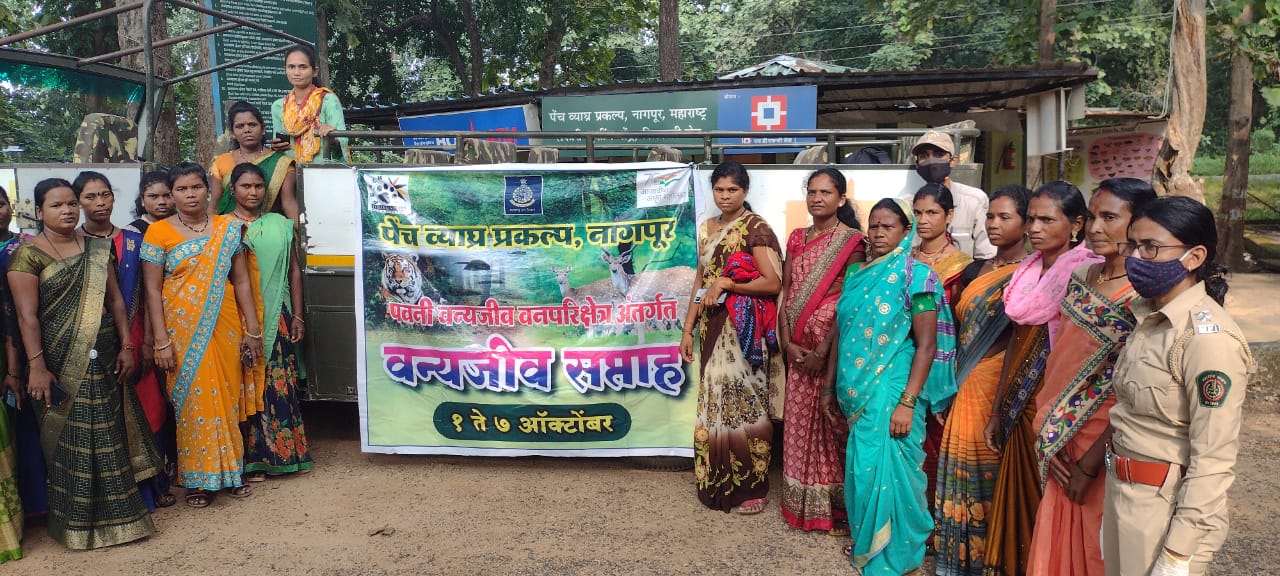
Satpuda Foundation organised a awareness film show for 120 school students of class 8-12 from Dahoda Adivasi Ashram School on the concluding day of the Wildlife Week 2021. During the film show, Mandar and Bandu showcased films on illicit pangolin poaching and trafficking. They also explained the students that superstition, poor economic conditions and bushmeat hunting are the major driving factors of pangolin poaching. Citing examples of few such cases from the villages of buffer area of Pench in the recent past, our staff urged the students to never indulge in such activities when they grow up and also report the local forest department staff if they ever come across such situation in their village. Later the students were also sensitized on issues ranging from wildlife corridors, human-wildlife conflicts, habitat loss etc.
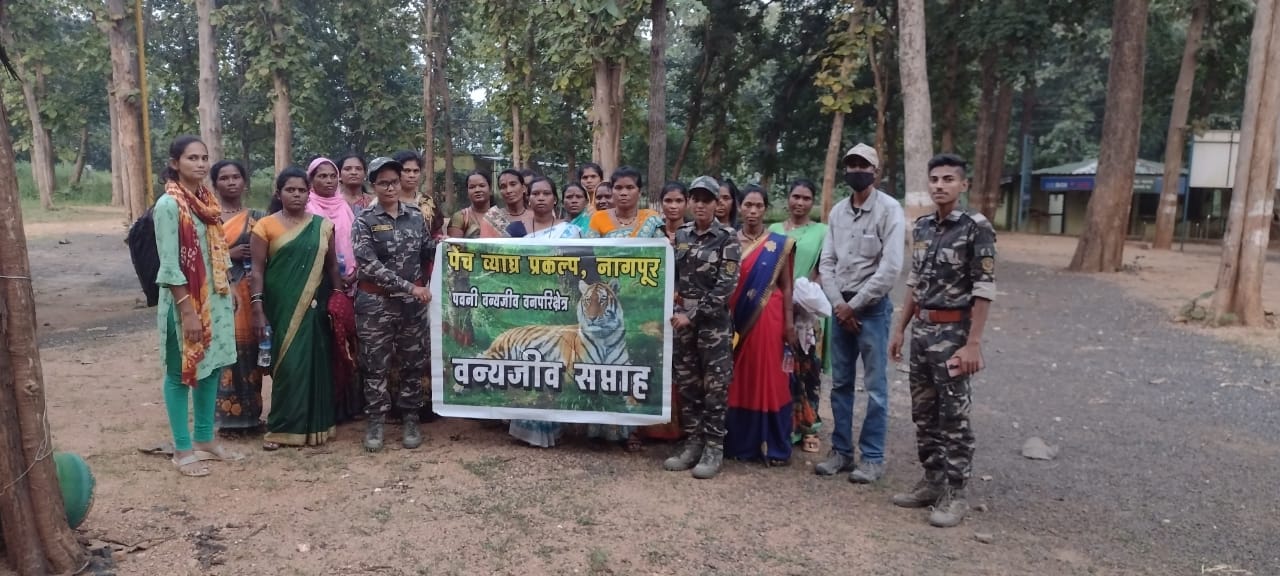
Later in the afternoon, a sensitisation program by means of jungle safari was arranged in collaboration with Pench Tiger Reserve administration. Field Director Mr Govekar and Deputy Director Mr Shukla provided a open canter for jungle safari. Staff members of the Rapid Response Unit deployed by forest department to tackle human-wildlife conflicts in the buffer area accompanied and interacted with the select 18 women from Sillari, Pipariya, Wagholi, Salai, Khapa and Ghoti villages of buffer area. These women were selected by our staff as they have volunteered to opt for alternate livelihoods so as to shun dependency on forests for livelihood. Mandar guided the group during the safari and helped them to spot numerous birds and animals such as sambar deer, axis deer, wild boars, gaur etc. During the safari Mandar explained the women the importance of Pench Tiger Reserve. As these villages are on the very fringe of the core area, the livestock depredation and crop losses by wildlife is high. Mandar explained that these women can act as leaders in their villages and better explain their fellow villagers to adopt wildlife conservation friendly practices and support forest department in their endeavour to protect our rich natural heritage. "Despite living so close to the tiger reserve, we never got a chance to visit and explore the natural beauty of the park. We got to understand the issues and threats to the forest in a better way", said Kunti Markam from Salai village during the safari. "As the tigress teaches her cubs, we will now teach our children to protect the forest", said Ambika Khandate of Wagholi village after visiting the Tiger Tale museum. "We now understand that the forest department staff is working for our benefit. There is no point in opposing them or pressuring them to capture or kill a tiger or leopard in case of cattle depredation", stated Sarita Maraskolhe from Khapa village.
Tiger from Maharashtra spotted in Nirmal district
Moulika.KV | Updated: Oct 3, 2021, 09:17 IST

HYDERABAD: A tiger from Tipeshwar Wildlife Sanctuary (TWS) in Maharashtra has now been traced in the buffer and eco-sensitive zone of Kubeer mandal of Nirmal district
Forest officials, who found the pugmarks of the big cat a few days ago, said that they were witnessing regular movement of the wild animals on the Maharashtra-Telangana border and there is one particular big cat, which has been regularly coming towards Nirmal district and going back to Maharashtra.
While the tiger was initially suspected to be 'Gabbar' which entered Bheempur mandal in Adilabad district about a month ago, the officials clarified that there were very few chances of the tiger entering into this part of the state. "It is difficult for a tiger to move towards this part (Kubeer mandal) from Adilabad due to full-fledged roads and highways in between. We will know better once we get some photographic evidence from the camera traps. So far, we only have the data pertaining to its pugmarks and cattle kills, " a forest official told STOI.
The last cattle kill was reported on Saturday morning in Bhainsa area after which a forest team inspected the site and submitted a verification report to the veterinarians. The veterinarians will study the sample of the kill and certify whether it was a tiger or a leopard kill, the foresters said.
Include communities in long-term conservation
Vijay Pinjarkar | Updated: Aug 8, 2021, 04:51 IST
Nagpur: A study conducted by the Network for Conserving Central India (NCCI), an umbrella group of 67 researchers and NGOs, has concluded that its work in the Central Indian Landscape (CIL) has provided pathways towards people-oriented conservation in a human-dominated landscape.
The study recommends including local communities is key to long-term conservation and development in regions such as Central India. The CIL includes several embedded tiger reserves like Kanha, Satpuda, Pench, Melghat, Tadoba, Navegaon-Nagzira, Bor, Kawal and Achanakmar and forest corridors that are essential for wildlife movement and genetic continuity across the landscape. The CIL harbours 29% of the country's tiger population.
A study 'Pathways towards people-oriented conservation in a human-dominated landscape: The network for conserving Central India' by conservationists Amrita Neelakantan, NCCI, Kishor Rithe, Satpuda Foundation, Gary Tabor, Centre for Large Landscape Conservation, USA, & Ruth DeFries, Columbia University, New York, shows that NCCI has provided a platform for collaborations in landscape-level conservation that maintains biodiversity and livelihoods for local people in a globally important tiger conservation region within a complex social-ecological system.
"Using the NCCI as an example, our study identifies indicators to track progress in collaborative landscape-level networks across four dimensions - the composition of the network, collaborative scientific output, dissemination of research outputs through social, electronic, and print media, and participation in policy and decision-making bodies, " says lead author Neelakantan.
Since 2013, the NCCI members conducted research that predominantly addressed human-wildlife conflicts and livelihood needs around PAs with less attention to forest ecology and climate.
"Our analyses highlight the NCCI's role as a knowledge platform and bridge among researchers, NGOs, and government, with significant opportunities for boundary work in the science, policy, and practice interface (SPPI). A challenging and unfulfilled goal is the engagement of local communities to co-produce approaches that balance conservation, local livelihoods, and development, " said another author Rithe.
"Researchers working in many conservation landscapes have identified the need to focus on human well-being alongside conservation goals and science-informed conservation networks to achieve a balance among multiple objectives that serve both present and future conditions, " said Rithe.
In the Central Indian region, the NCCI has helped provide a knowledge-base and a platform for collaborations that improve the well-being of local communities, conserve habitat for wildlife, protect watersheds, promote sustainable tourism, and accommodate development needs for improved infrastructure.
The CIL spans across MP, Chhattisgarh, & Maharashtra encompassing more than 4.50 lakh sqkm. The NCCI is evolving into a bridge institution to address the difficult challenge of fostering bottom-up involvement of local communities to further democratize the top-down decision-making structure.
It states that networks of NGOs alongside other stakeholders are especially important for local communities who have few avenues to engage in policy and decision-making even at the local scale. NGOs play a crucial role in providing a bridge for wildlife, stakeholders, and policy-makers.
Global Tiger Day 2021 celebrated with great fervour in Pench Tiger Reserve, Maharashtra
Updated: 29 July 2021
Global Tiger Day 2021 was celebrated in villages of buffer area of Pench Tiger Reserve. On the occasion, a rally was organised to create awareness about benefits of tiger and wildlife conservation. Village children, youths, eco-tourism guides, gypsy drivers along with forest department staff took part in the rally. Posters painted by the village children depicting messages such as 'Tiger is our friend', 'Let's conserve tigers and wildlife', 'Stop poaching, start protecting' so as to make the villagers aware about issues and solutions for tiger conservation. These posters were put up in the front of bicycles which led the procession. The rally procession was flagged off from the Sillari eco-tourism gate of the Pench Tiger Reserve at the hands of Mr Parab, ACF for Special Tiger Protection Force and Mr Tate, RFO for East Pench Range. Satpuda Foundation's (SF) Assistant Director Mr Mandar Pingle, SF's Conservation Officer Mr Bandu Uikey and Ms Prajapati of PACE Foundation were also present during the flag-off.
As the rally procession reached its first halt in Sillari village, the children, village youths, guides and forest department staff raised slogans to encourage villagers to contribute towards tiger and wildlife conservation initiatives. Rally participants raised slogans to make the villagers aware about various threats to tigers such as poaching, electrocution, poisoning mostly done for superstition and black magic. Along with this people were made aware about harms of habitat loss due to overgrazing, deforestation, illicit tree felling and encroachment of forest lands as direct threats to tiger population. The procession proceeded further passing through lanes of Pipariya village and making its residents aware about these issues. The rally participants also planted 30 odd saplings of indigenous tree species such as karanj and tamarind alongside the Pipariya to Salai village road before the rally culminated in Ghoti village. Village children and the nearby farmers have taken up the responsibility for the survival of the planted saplings.
In Ghoti village, RFO Mr Tate, Round Officer Mr Parikar, VEDC president Mr Warkhade and vice-president Mr Lanjewar distributed cattles to five beneficiaries of the village. These good quality cattle breeds were purchased with the help of funds received through the Dr Shyama Prasad Mukherjee Jan Van Vikas Yojna in order to improve livelihood through livestock management and also to reduce grazing in forest area. The beneficiaries had earlier sold their cattle which they used to take inside the national park boundary for grazing. This sometimes led to conflict situations where tiger attacked and killed their cattle. A prize distribution was arranged for children who had participated in a drawing and painting competition. These children were earlier provided with paints and paper sheets and asked to draw and paint pictures depicting the tiger in its habitat. The winners of the competition were pesented with school backpacks by the VEDC. RFO Mr Tate presented the prizes to the children.
Round officer Mr Parikar, Satpuda Foundation's Bandu Uikey and young volunteers Pawan Chincholkar and Divyam Walke along with Ghoti VEDC vice-president Mr Lanjewar took efforts to make the event successful.
Film shows help Pench buffer villagers shed vax hesitancy | Nagpur News - Times of India
Vijay Pinjarkar | Updated: Jun 30, 2021, 11:56 IST

NAGPUR: A month ago, getting people vaccinated in the buffer villages of Pench Tiger Reserve (PTR), Maharashtra, was more difficult than tiger conservation. Today, with the intervention of wildlife conservation NGO Satpuda Foundation, locals are coming forward to get inoculated and ward off Covid.
In April, when Covid-19 had spread its tentacles in rural areas, tribal villagers surrounding Pench buffer initially agreed to take the vaccine. However, some of those bearing comorbidities died despite getting jabbed. Victims also included patients who were Covid positive but showed reluctance to go for tests.
"This sent a wrong message among the locals, who were then scared to get inoculated, and did not even allow vaccination teams in their villages. The general perception was that they will die after getting the vaccine shot, " said Kishor Rithe, president, Satpuda Foundation.
However, added Rithe, "Our mobile health unit involved in regular non-Covid health check-ups in buffer villages was allowed, uninterrupted. We seized this opportunity by showing films and audio-visuals to sensitize people. The plan is working now."
Last week, the NGO organized free non-Covid health camps for Pench buffer villages, covering Usripar, Ghoti (I & II), Kadbikheda, Kirangisarra and Jamuniya.
Along with free consultation by an experienced doctor, people's blood pressure, sugar and pulse levels were checked and medicines offered. "Since last month, our team, along with the offices of Ramtek tehsildar and Deolapar subdivisional officer (SDO), is engaged in creating awareness regarding Covid testing and vaccination, " said Mandar Pingle, senior field officer.
"We are showcasing audio-visuals to help villagers understand precautions to prevent Covid spread and also clear misconceptions and myths regarding vaccination. Positive impact of the drive can be seen this week as a good number of people between 18-45 years of age have now turned up for vaccination drives in Pipariya, Ghoti, Sillari, " said Rithe.
Even members of the Vyaghra Mitra Mandals, known as primary response teams (PRTs), guides and gypsy drivers are now getting themselves vaccinated in large numbers.
Nagesh Maraskolhe (25, a resident of Sillari) said, "There was a sense of fear during the first vaccination drive as many messages were circulating on social media about deaths caused by the vaccine. As a result, I was hesitant to take it."
However, said Maraskhole, "We were made aware about precautions to prevent Covid spread during a film show by Satpuda Foundation in our village this month. The best part is that people are undergoing free health check-ups by Satpuda Foundation before getting vaccinated. I got my first shot a few days back and will take the second jab as well."
4-member panel to study wildlife clearance to Reliance Cement in Yavatmal
Vijay Pinjarkar | Updated: Jun 2, 2021, 14:44 IST

NAGPUR: The greenfield cement project of Birla Corporation Limited's wholly owned subsidiary Reliance Cement Company Private Limited (RCCPL) in Mukutban area of Yavatmal district will have to wait for now as a four-member committee has been appointed to study the wildlife clearance proposal.
The RCCPL on January 22, 2018, had received Stage-II clearance from the environment ministry for the diversion of 467.45 hectares reserved forest land under the Forest (Conservation) Act, 1980. There was no mention about clearance from the forest department's wildlife wing.
The tiger-bearing area falls in compartment numbers C-26, C-27, and C-33(A) falling in Hirapur, Govindpur, and Pimparwadi villages in Zari-Jamni taluka under Pandharkawada forest division in Yavatmal forest circle.
According to the documents, there are resident tigers in the diverted area. On April 26, a gravid tigress with four cubs in the womb was burnt to death by miscreants in the Mukutban range. The area is on the northern side of the proposed cement plant.
The land diversion hit hurdles in 2019 when it was found that the entire forest area proposed to be diverted falls in the tiger corridor of Tipeshwar wildlife sanctuary-Tadoba-Andhari and Kawal tiger reserves.
The patch is also the part of the Tiger Conservation Plan (TCP) approved by the National Tiger Conservation Authority (TATR) in 2016-26. Section 38 (O) (1) (g) of the Wildlife (Protection) Act (WPA), 1972, calls "to ensure that tiger reserves and areas linking one protected area or tiger reserve with another protected area or tiger reserve are not diverted for ecologically unsustainable uses, except in public interest and with the approval of the National Board for Wildlife (NBWL) and on the advice of the NTCA".
The NTCA too had sought a report about the project falling in the corridor. Accordingly, PCCF (wildlife) Nitin H Kakodkar had sought a proposal on wildlife clearance from then filed director of Melghat Tiger Reserve (MTR).
"Now, before clearing the ground for wildlife clearance, the state chief wildlife warden has set up a four-member committee to study the proposal. The committee will conduct a site visit before making a decision, " said sources.
The committee will be headed by CCF & field director of MTR, conservator of Yavatmal Circle, state wildlife board member Kishor Rithe, and Yavatmal honorary wildlife warden Ramzan Virani. The committee has been asked to submit the report in one month.
TOI on August 26, 2019, was the first to report about it. The company will now have to seek clearances from the State Board for Wildlife (SBWL) followed by NBWL.
In 2018, clearance to the Reliance cement project had snowballed into a big controversy as wildlife activists alleged Pandharkawda tigress T1 aka Avni was shot dead to pave the way for the cement plant. But the proposed area is 70km (as crow flies) from T1 territory.
Sources said the forest to be diverted is of high value with 0.4 density. There are resident tigers in the area and the forest is contiguous the plant will break connectivity.
The application seeking diversion of forest land was officially moved in July 2009 and in-principle approval came in 2012, but due to non-compliances, the proposal was pending. The final approval came in January 2018 after completing all the formalities including payment of net present value (NPV). The Birla Corporation plans to invest Rs2, 400 crore in the project.
News 2020
Maharashtra environment group member moves SC, says 656 forest officers assaulted over 10 years
Badri Chatterjee | Updated: Oct 16, 2020 19:48 IST
 Citing an alarming increase in the frequency and ferocity of assaults on
forest officers particularly in Madhya Pradesh, Maharashtra, and Rajasthan,
a Maharashtra-based environment group has moved the Supreme Court for
solutions.
Citing an alarming increase in the frequency and ferocity of assaults on
forest officers particularly in Madhya Pradesh, Maharashtra, and Rajasthan,
a Maharashtra-based environment group has moved the Supreme Court for
solutions.
Kishor Rithe has filed an interim application through his NGO Nature Conservation Society, Amravati, against the Centre, chief secretaries of Maharashtra, Madhya Pradesh and Rajasthan, district collectors of areas, where the assaults have been reported, and the directors-general of police of the three states. It requests the court to direct the Centre to ensure the protection of officers and staff of the forest departments, provide social security, ex-gratia payments, and medical treatment costs of the injured personnel. The application has also sought speedy investigations into the attacks.
The court has admitted the application.
According to data collected from territorial forest areas (11 circles), wildlife sanctuaries, national parks, and tiger reserves in Maharashtra (except Dhule and Kolhapur), 656 forest officers have been injured in assaults between 2010 and 2020. As many as 47.5% of the assaults were reported between 2017 and 2020. Twenty-four forest officers have been killed in Maharashtra over 10 years. Rithe is collecting similar data for Madhya Pradesh and Rajasthan.
"The involvement of a large number of people, mostly encroachers and those belonging to timber mafia armed with deadly weapons, has led to serious injuries to the forest personnel on duty, many of whom have been hospitalised and are in critical condition, " the application said. It added these attacks have had a chilling impact and made it increasingly difficult to protect forests.
Rithe said a majority of the attacks on the forest department officials are mainly carried out while removing encroachments. "So, saving forest lands has been most difficult in India, " he said. "The problem is widespread in other states also with a more serious situation in MP [Madhya Pradesh]."
Nitin Kakodkar, Maharashtra's principal chief conservator of forest (wildlife), said the assaults have been reported for a long time now but there has been a surge in the recent months. "It definitely needs some redressal. Let us see what the SC [Supreme Court] has to say about this."
On September 2, the Indian Forest Services Officers Association made a representation to Union environment minister Prakash Javadekar seeking better protection and social security for over 50, 000 personnel working in remote areas.
Satpuda Foundation volunteers construct check dam for wildlife
Vijay Pinjarkar | Updated: Oct 4, 2020 19:05 IST
 To tackle water crisis for wild animals during summer, Satpuda Foundation's
young members of the Vyaghra Mitra Mandal from Khapa village constructed a
check dam to make available water during summer for wild animals.
To tackle water crisis for wild animals during summer, Satpuda Foundation's
young members of the Vyaghra Mitra Mandal from Khapa village constructed a
check dam to make available water during summer for wild animals.
These youths are part of a primary response team (PRT) formed by Satpuda Foundation, an NGO working for wildlife conservation in Central India, to reduce human-wildlife conflict in the buffer area of Pench Tiger Reserve (PTR) in Maharashtra.
Seven youths with assistance from Satpuda Foundation constructed a check dam on a stream in the forest area near Khapa. Krishna Madavi, a wildlife lover and regular volunteer of Satpuda Foundation, said, "We constructed this check dam so that water is available for wildlife and livestock too."
Pipariya gram panchayat sarpanch Shekhar Khandate said the PRT along with Satpuda Foundation and the forest department is actively working to reduce human-wildlife conflict.
Field assistant Dilip Lanjewar said the check dam construction will help prevent wildlife conflicts and also provide water for agriculture.
Conservation officer for Satpuda Bandu Uikey said the project will not only help animals but communities too. Similar activities have been planned during the week in other villages of the buffer area of Pench.
"Braving Covid-19 these community members are openly coming out by following social distancing norms for wildlife conservation. This is truly humbling and inspiring, " says Mandar Pingle, assistant director of Satpuda Foundation.
Kishor Rithe, founder Satpuda Foundation, said, "Community participation is key for long-term wildlife conservation and undertaking such activities have huge positive impacts on wildlife conservation on the ground."
Ramnath Kokode, Dharmaraj Kumare, Sahdeo Tumdam, Krishna Madavi, Rohidas Kumre, Rajkumar Kokode and Ranjit Uikey of Khapa village volunteered during the shramdaan programme.
Wildlife regularly uses 27 overpasses built over Maharashtra canal:
Irrigation department
Badri Chatterjee | Updated: Aug 28, 2020 15:16 IST
 The canal passes through protected areas such as Umred Pauni Karhandla
Wildlife Sanctuary and Tiger Reserve as well as the Tadoba Andhari Tiger
Reserve
The canal passes through protected areas such as Umred Pauni Karhandla
Wildlife Sanctuary and Tiger Reserve as well as the Tadoba Andhari Tiger
Reserve
Wild animals, including tigers, are using overpasses built atop an irrigation project on the Wainganga river in Maharashtra, underscoring the importance of built-in mitigation measures for linear infrastructure and other developmental projects.
The state irrigation department informed a sub-committee of the State Board of Wildlife (SBWL) authorities during a meeting on Thursday evening that they had completed constructing 27 of 54 overpasses that are on average 30 to 50 metre (m) wide each. The underpasses are built over the 99-kilometre (km) Gosikhurd irrigation canal, which extends from Bhandara to Chandrapur districts. The canal passes through protected areas such as Umred Pauni Karhandla Wildlife Sanctuary and Tiger Reserve as well as the Tadoba Andhari Tiger Reserve (TATR).
Irrigation department officials stated that tigers were using the overpasses across at least two locations in south Brahmapuri region surrounded by fragmented forest patches. They also shared photographs to bolster their contention.
"We have documented tiger movement across Halda and Wandra areas in this region, where photographs have been taken over the past year at two specific overpasses. However, there are reports of several other areas, where local villagers have spotted tigers and other animals, including deer, boars, wild dogs etc, all using these overpasses, " said JM Shaikh, chief engineer (projects), Vidarbha Irrigation Development Corporation (VIDC).
The Gosikhurd project starts from Pauni in Bhandara district and it was inaugurated on April 22, 1988, to divert water to Wainganga, Wardha and Tapi basin and annually irrigate 3.38 lakh hectares (ha) in around 720 villages in western Vidarbha.
The break-up of the areas irrigated annually in Bhandara, Nagpur and Chandrapur districts are 89, 856 ha, 19, 481 ha and Chandrapur 1, 41, 463 ha, respectively, in a bid to boost commercial crop production.
This is the first irrigation project in Maharashtra that has built-in wildlife mitigation measures, the state forest department authorities said.
"The feasibility of these overpasses shows that we need many more such structures to ensure the uninterrupted movement of big cats and other animals and are not deterred due to developmental models, " said Nitin Kakodkar, principal chief conservator of forests (PPCF) (wildlife), Maharashtra. He claimed that this could be one of the first wildlife passages built over a canal in the country.
The forest department has planned a study by setting up camera traps in the area. "Over six months, we hope to get an idea of how many tigers or other animals are using these structures, " said Kakodkar.
A February 2020 report by the Wildlife Institute of India (WII), Dehradun, had recorded 5, 450 wild animal photographs captured through camera traps over a 10 month period - between March and December 2019 -- across nine underpasses along the National Highway (NH)-7 near the Pench Tiger Reserve in Maharashtra.
The study documented 18 animal species using these mitigation measures, including 11 tigers using six of the nine underpasses.
Kishor Rithe, member, SBWL, said, "At present, these wildlife overpasses are concrete structures. The fact that it is being used is the first step. We have suggested that there should be greening of these structures with soil and vegetation to resemble forest in a bid to encourage the animals to use them regularly. Besides, they should be made in such a way to discourage local villagers from using their vehicles. Boulders can be put up to ensure unhindered movement of animals."
Though the original proposal was to build 64 overpasses, it was realised that 54 overpasses were sufficient following site-specific studies, said Shaikh. While 27 have been constructed across the 99-km stretch since 2017, 10 are under construction ranging from 47 to 99 km.
Of the remaining proposed underpasses, local villagers have opposed the construction of five that are located within the first 30 km. "However, three structures can be built, " said Shaikh.
Kakodkar said, "The irrigation department has informed us about the opposition from local villagers due to fear of tigers and other carnivores entering the agricultural landscape leading to conflict."
Rithe said a team of non-government members and forest officials from the sub-committee would visit the site to assess alternate options for constructing the five overpasses.
40, 000 tigers in 1900, why can't we hold 3, 000 now: Rithe
Vijay Pinjarkar | TNN | Updated: Jul 28, 2020, 23:40 IST
NAGPUR: In some good new amid the Covid-19 pandemic, India's tiger population has showed a steady increase from 2, 226 in 2014 to 2, 967 in 2018. This was possible as individual reserves have been shining as an outcome of village resettlement works and containing poaching threats.
Talking to media on eve of Global Tiger Day , Kishor Rithe, working for tiger conservation in Vidarbha landscape, said, "Some 30 years ago, we had a dream to regain our lost tiger population and focused on resolving key issues like huge anthropogenic pressure from villages situated in the core areas and rampant poaching."
The Maharashtra government brought out a lucrative relocation package and expedited village resettlement work and also took several measures to arrest poaching threat due to which tiger population increased from 100 to 300 in last 30 years in the state. "This is really laudable and it happened due to political will and committed forest officers, " Rithe stated.
However, with growing tiger population a section of officials have coined the idea to shift 50 tigers from Vidarbha landscape and sterilize male tigers. "I want to remind them that India had 40, 000 tigers in 1900. If the forests of this country could host 40, 000 tigers in 1900, why can't it host 3, 500 tigers today?" he asked. It is a problem of management and not tigers, he adds.
Rithe said the real solutions lie in strengthening tiger corridors and regaining fragmented habitats lost due to due to infrastructure projects and agricultural encroachments. "Linear infrastructure projects like expressways, highways, railways, irrigation canals and transmission lines are coming up in the corridors causing problems for tiger survival."
"Agriculture encroachments are fragmenting tiger corridors outside PAs and tiger reserves. The surface transport, railways, water resources ministries are reluctant to accept responsibility of avoiding tiger corridors and adopt appropriate mitigation measures on their own while deciding project alignments. Why do they need NGOs and courts to tell them to do it?" Rithe asked.
"We have not reached a tiger number to start thinking about sterilizing tigers or translocating them. We only need to strengthen corridors. On the Global Tiger Day, respective departments need to take a pledge for green infrastructures and readiness to protect tiger corridors, " said Rithe.
The ministry of road transport and highways issued order on May 29, 2019, to bypass PAs while deciding its alignments, even if it requires taking a longer route.
Former chief minister Devendra Fadnavis allocated enough money for wildlife mitigation structures on Mumbai-Nagpur Samruddhi expressway. Present chief minister Uddhav Thackeray asked to upgrade Akola-Khandwa meter gauge line from outside the core area of Melghat tiger reserve. "These are positive developments for tiger conservation and it will take work to the next level, " he applauded.
Fresh move to push railway line through Melghat reserve
Vijay Pinjarkar | TNN | Jul 11, 2020, 04:58 IST
NAGPUR: Nagpur: In a fresh move, the BJP government at the Centre wants the Maharashtra government to reconsider the forest land diversion proposal for upgradation of railway line passing through Melghat Tiger Reserve (MTR). The Melghat railway line issue was one among other pending infrastructure projects discussed on July 7 during the Group of Infrastructure meeting between highways minister Nitin Gadkari, railway minister Piyush Goyal and environment minister Prakash Javadekar, and officials of department concerned.
In the meeting, railway officials submitted that the standing committee of National Board for Wildlife (NBWL) on February 25, 2019, returned the proposal to Maharashtra government for submissions and comments, which are awaited. To this, the ministers expressed displeasure against state for non-submission of comments.
"We have apprised the state government about the Group of Infrastructure meeting, and displeasure expressed by the ministers, " said APCCF & nodal officer Sanjeev Gaur.
Of the 176km railway line - Akola-Akot (44km), Akot-Amlakhurd (78km), and Amlakhurd-Khandwa (54km) - 35km falls inside tiger reserve, of which 18km passes through the core area. The South Central Railway (SCR) requires forest diversion of 161 hectare area. The railway ministry has sanctioned Rs1, 421.25 crore for the project.
On February 25, NBWL had rejected the proposal and returned it to the state government. The National Tiger Conservation Authority (NTCA) and Wildlife Institute of India (WII) in their comments had recommended that only feasible mitigation is 'avoidance' of gauge conversion and alternate routes or alignments bypassing the tiger reserve should be taken up.
State wildlife board member Kishor Rithe said, "I don't think chief minister Uddhav Thackeray, who was so sensitive about Aarey in Mumbai and did not allow trees to be cut, will ever allow such massive destruction through core area of Melghat, where rich biodiversity will be destroyed and thousands of trees will be felled."
Environment lawyer Manish Jeswani, who had moved Supreme Court's Central Empowered Committee (CEC) on the issue, said, "No mitigation steps will match the ecological damage. NTCA and WII have clearly said 'alternate route' is best mitigation. Hence, there is no question of reconsideration. The proposal was sent back to the state in February last when BJP-Sena government was in power and it too had opposed gauge conversion through Melghat."
In March, Shiv Sena MP from Buldhana Prataprao Jadhav opposed railway line through Melghat and said the gauge conversion will, in the long run, increase train traffic resulting in huge disturbance to presence of tigers and other wildlife in the area. Alternate route will be a win-win situation for all. "The Wan sanctuary of tiger reserve has been made inviolate by rehabilitating 13 villages from core area by spending over Rs402 crore. The gauge conversion will reverse the benefits accrued from rehabilitation and habitat development, " said Jadhav.
Many from Vid on state wildlife board
TNN | Jul 8, 2020, 05:17 IST
NAGPUR: The State Board for Wildlife (SBWL), Maharashtra's topmost statutory body to deal with projects affecting tiger reserves, national parks and sanctuaries, was on Tuesday reconstituted with Vidarbha getting good representation.
The SBWL is headed by chief minister Uddhav Thackeray and forest minister Sanjay Rathod is vice-president, while PCCF (wildlife) Nitin Kakodkar is its member-secretary. The reconstituted board will have 29 members including PCCF, eight wildlife experts, six representatives of NGOs and government-owned institutions and top officials of various departments concerned.
Main functions of the SBWL, formed under Section 6 of Wildlife Protection Act, 1972 in all states, are conservation and protection of wildlife in protected areas, selection and appraisal of areas to be declared as sanctuaries etc.
The term of the last SBWL expired in November 2019. Six non-government members who have been appointed on the board include Bittu Sahgal (Mumbai), Kishor Rithe (Amravati), Poonam Dhanwatey & Kundan Hate (Nagpur), Anuj Khare (Pune), Yadav Tarte Patil (Amravati), Suhas Waigaokar (Kolhapur), and Vishwas Katdhare (Ratnagiri).
The board will also have top NGOs working for wildlife including Anish Andheria of Wildlife Conservation Trust (WCT), Bandu Dhotre of Eco-Pro, Chandrapur, Deepak Apte of Bombay Natural History Society (BNHS). It will also have representatives of Botanical Survey of India (BSI), Zoological Survey of India (ZSI) and Wildlife Institute of India (WII), Dehradun.
Withhold forest and eco clearances amid pandemic: Experts urge minister
TNN | Updated: May 14, 2020, 14:25 IST
Vijay Pinjarkar
NAGPUR: Over 200 intellectuals, researchers, wildlife and forest experts have moved Union environment minister Prakash Javadekar to withhold forest and environmental clearances during the Covid-19 pandemic.
Covid-19 outbreak and subsequent lockdown across the nation have created extraordinary challenges for India's citizens and for governance. The measures that the government has taken to adapt to this unprecedented situation include a shift to online platforms for consultation and decision-making.
"However, these measures are still inadequate and we have grave concerns about the manner in which forest and environment clearances are being granted during this pandemic, " they said.
Among the signatories include former National Board for Wildlife (NBWL) members MK Ranjitsinh, AJT Johnsingh, Asad Rahmani, Belinda Wright, Bittu Sahgal, Biswajit Mohanty, Kishor Rithe, Prerna Singh Bindra, Claude Alvares, Divyabhanusinh Chavda, Praveen Bhargav, Shekar Dattatri and others.
The central government and various statutory authorities are under orders of apex court to ensure that forest and environment clearances comply strictly with the guidelines laid down in the Lafarge Judgment of 2011.
"Meeting via videoconferencing handicaps such authorities from carrying out the roles that they are mandated to fulfil by the Supreme Court. Therefore, the decisions taken at the 57th meeting of the standing committee of NBWL on April 7, 2020 related to 31 proposals affecting 15 tiger reserves, sanctuaries, notified eco-sensitive zones (ESZ), deemed ESZs on the fringes of protected area and designated wildlife corridors must not be implemented and must be visited afresh following due process after the end of the pandemic, " they said.
First, site inspections, which are a crucial component of project evaluation, are very difficult to implement during a pandemic. Appraisals and assessments for clearance are being reduced to an mere formality, lacking credibility. Site inspections may be necessary and it is inconceivable that clearances can be granted in all cases without site inspections by experts.
Second, due to the national lockdown since March 25, the ministry appears to be relying only on digital documents uploaded by project developers on single-window clearance portal - Parivesh.
Supreme Court guidelines have specifically pointed out that identification of an area as forest solely based on the declaration by the user agency is leading to fait accompli situations. The compliance of these norms may not be possible during the lockdown which may amount to a serious deviation in the clearance process.
Under normal circumstances, project developers would be expected to provide documents that elucidate a project's impact on environment for clarification during in-person meetings. In several instances, documents are also requested via Speed Post, which may not be possible due to travel restrictions.
Third, as a result of travel restrictions, Covid-19 distancing and other hardships to livelihoods during the lockdown, it is difficult to implement the ministry's own mandated procedures in the foreseeable future.
"In view of the compelling facts and circumstances outlined above, we request that implementation of decisions taken by the NBWL via videoconferencing be held in abeyance until pandemic-related travel restrictions are lifted to allow in-person meetings and travel to project sites for fresh appraisals following due process, " said the experts.
"We further urge that all meetings of NBWL, Forest Advisory Committee (FAC) and all the 10 EACs be postponed as long as travel restrictions make verification of documents during in-person meetings, local representations, and site visits difficult, " they added.
Education van for children of Mowgli's Pench landscape on World Forest Day
DHNS, Mumbai, | Updated: MAR 21 2020, 08:47AM IST
Mrityunjay Bose

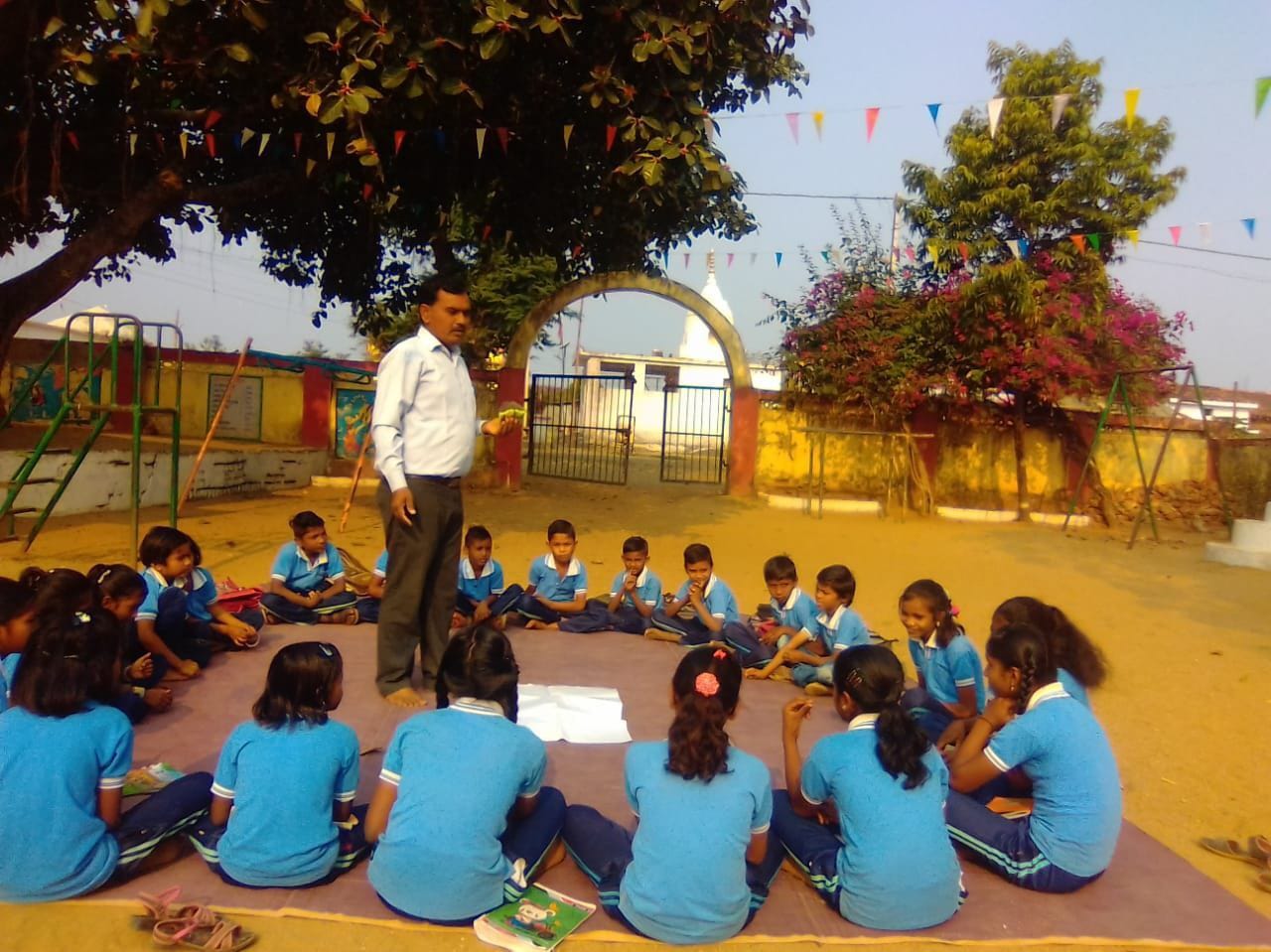 Celebrating a quiet World Forest Day because of COVID-19, the Satpuda
Foundation (SF) has announced a gift for children of Mowgli's Pench
landscape: an education van for the Pench Tiger Reserve in Nagpur district
of Maharashtra.
Celebrating a quiet World Forest Day because of COVID-19, the Satpuda
Foundation (SF) has announced a gift for children of Mowgli's Pench
landscape: an education van for the Pench Tiger Reserve in Nagpur district
of Maharashtra.
"The education van was planned to be inaugurated on World Forest Day in Pench, however, we have postponed the programme as the schools are closed and social gatherings are banned to prevent from the infection of COVID-19, " said veteran conservationist and SF founder Kishor Rithe.
Follow latest updates on the COVID-19 pandemic here
Satpuda Foundation, one of the leading NGOs in central India has been working on environment education programme since 2001 in Pench and other Tiger reserves. This year the SF has designed a science-based conservation education programme aiming for the tiger conservation. The project is funded by B C Mehta trust in England through "The Fable Fund".
The well-equipped education van will operate in 26 buffer villages of Pench Tiger Reserve showing films on "conservation and benefits" to children, organise interactive programmes with tribal youths to provide them livelihood opportunities and also focus on reducing anthropogenic pressure on tiger habitat by mobilising village eco-development committees, said Mandar Pingle, Education officer working on this project.
"Satpuda Foundation has already recorded many achievements in the Pench landscape and we hope that the Fable Fund will bring measurable change in the Tiger conservation scenario", said Nikita Mehta of B C Mehta Trust.
Mobile health services help villagers in tiger reserve fight COVID-19
DHNS, Mumbai, | Updated: MAR 20 2020, 11:39AM IST
Mrityunjay Bose
 A unique mobile health service (MHS) is helping the tribal villages of Pench
to prevent COVID-19 infection. The initiative was started by Satpuda
Foundation (SF) to serve in the Tiger Reserve buffer villages in January
2014.
A unique mobile health service (MHS) is helping the tribal villages of Pench
to prevent COVID-19 infection. The initiative was started by Satpuda
Foundation (SF) to serve in the Tiger Reserve buffer villages in January
2014.
The SF Mobile Health Service has conducted health camps in six buffer villages and treated 300 patients from Wagholi, Sillari, Khursapar, Sawara, Khapa and Ghoti. There are hundreds of examples.
Follow live updates of coronavirus cases in India here
"Patients suffering from fever and cough were particularly worried about the possibility of having the virus infection. However, the MHS doctors made the patients aware of the symptoms of coronavirus and the routine fever and cough, " Satpuda Foundation founder Kishor Rithe said.
The MHS also made the patients aware of the dos and don'ts to prevent the virus infection.
Dr Manohar Khode, who has more than 20 years experience of serving in the tribal villages of Melghat, treated the patients and interacted with them.
The MHS has treated around 70, 000 patients in the last six years and also provided the patients with further support for surgeries, eye operations and dental extractions.
Section 144 was imposed in Nagpur city and academic institutions too decided to close down to prevent the spread of COVID-19. The health sector is serving the public day and night.
Environmentalists oppose Human dam project revival plan in Maharashtra
DHNS, Mumbai, | Updated: JAN 21 2020, 09:24AM IST
Mrityunjay Bose
The Maharashtra government's move to revive the Human dam project at Tadoba in Chandrapur district is being strongly opposed by environmentalists saying that it would have far-reaching consequences on the tiger habitat.
At an expert committee meeting held in Mantralaya, convened by Vikas Kharge, principal secretary to Maharashtra Chief Minister Uddhav Thackeray, environmentalists registered their strong opposition to the project.
In the meeting, Bombay Natural History Society (BNHS) director Dr Deepak Apte, Satpuda Foundation founder Kishor Rithe, Eco-Pro president Bandu Dhotre, who are also NGO members, opposed the project.
"We have opposed the Human dam project, " said Rithe.
The irrigation project is to be built across Human river in Wainganga/Godavari basin near Sirkada village in Sindewadi tehsil of Chandrapur district. The Human river is a tributary of Andhari river, which ultimately joins Wainganga.
The submergence and downstream area between Tadoba-Andhari Tiger Reserve and Brahmapuri Forest Division is a tiger corridor that connects other tiger source populations in the Satpuda-Maikal tiger landscape. Tadoba landscape is home to over 160 tigers, environmentalists pointed out.
A BNHS report pointed out that the villages that would be fully submerged are Palasgaon, Piapra-Perna, Sirkada, Vihirgaon, Manemohadik, Khambada, Gondeda, Kewada, Pendhari is the narrowest tiger corridor between Chandrapur and Brahmapuri forest divisions. Besides tiger, the area has a good population of leopards, sloth bear and wild dogs.
Greens see red as forest cover in 12 tribal dists down
TNN | Updated: Jan 4, 2020, 4:13 IST
Vijay Pinjarkar
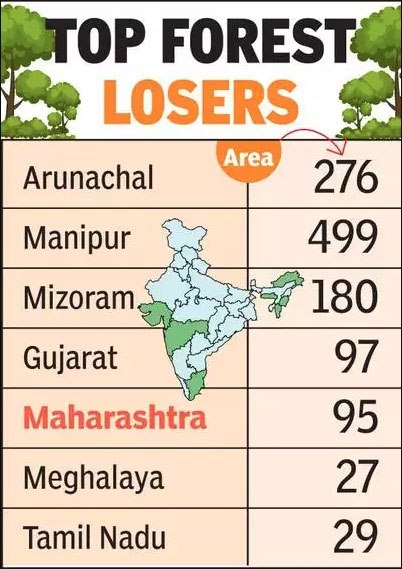 NAGPUR: NGOs and civil society organizations working for
tribal rights always claim that it is the tribals who are the real
protectors of forests. But, the data in recently released Indian State of
Forest Report-2019 states that forest cover in tribal districts have
drastically fallen.
NAGPUR: NGOs and civil society organizations working for
tribal rights always claim that it is the tribals who are the real
protectors of forests. But, the data in recently released Indian State of
Forest Report-2019 states that forest cover in tribal districts have
drastically fallen.
As per the ISFR-2019, Maharashtra has lost very dense forest (VDF), moderate dense forest (MDF) and open forest (OF) to the size of 63sqkm, an area half of Tadoba National Park (125sqkm), in recorded forest area (RFA) and 31sqkm outside RFA.
As per the latest report, forest cover in the state is 50, 777.56 sqkm. In 2017, the cover was 50, 682sqkm. So, even as Maharashtra has gained 95.56sqkm of forest, it lost equal amount of dense forest in 12 tribal districts.
Forests play an important role in the socio-cultural and economic life of the tribal people. Hence, Forest Survey of India (FSI) monitors and analyse the forest cover in tribal districts.
There are 218 tribal districts in 27 states/union territories. As per the report, though there is an overall increase in forest cover in tribal districts by 1, 181 sqkm, forest cover inside the RFA in tribal districts shows a decrease of 741 sqkm. RFAs are recorded as forests in government records.
In Maharashtra, there are 12 tribals districts with a geographical area of 1, 44, 233 sqkm. These districts include Ahmednagar, Amravati, Akola, Aurangabad, Beed, Bhandara, Buldhana, Chandrapur, Dhule, Gadchiroli, Gondia, and Nandurbar.
A comparison with ISFR-2017 shows that Maharashtra lost forest cover in all the three categories in these tribal districts. Forest area of all the three categories was 25, 112sqkm in 2017. In 2019, it was recorded as 25, 049, a loss of 63sqkm. But 31sqkm was also lost outside RFA.
PCCF (HoFF) Dr N Rambabu said, "We are evaluating the areas where FSI has reported change. Till then it will not be proper to tell the reasons for decline in cover in these districts."
The VDF was 6, 902 sqkm while in 2019 it was 6, 891 sqkm, a loss of 11sqkm. Similarly, MDF was 9, 850sqkm, which was recorded as 9, 813sqkm, a loss of 37sqkm, and open forest, which was 8, 360sqkm in 2017, was recorded as 8, 345sqkm, a loss of 15sqkm.
Wildlife experts have attributed one of the major reasons to loss of forest in tribal districts to encroachments under individual forest rights (IFRs) of Forest Rights Act (FRA), 2006.
"FRA implementation started in 2007. Most of our best quality forests are in tribal districts only. Surprisingly, forest cover has continued to decline in all these districts since 2011 till date, " says wildlife conservationist Kishor Rithe.
"This also reflects in district-wise forest cover in Maharashtra where it has declined in 9 of the 12 tribal districts. Gadchiroli, where most of the CFRs and IFRs have been granted, lost 87sqkm area, followed by Chandrapur (35sqkm), " says Debi Goenka, executive trustee, Conservation Action Trust (CAT).
"I'm not ready to believe forest cover has increased. The loss of cover in tribal districts is apparently due to FRA encroachments. In Tadoba buffer alone, 400 hectare area has been encroached upon by people, " said Gadchiroli honorary wildlife warden Uday Patel.
"Besides FRA, felling of natural forest by FDCM and heavy logging operations are also big reasons. Plantations cannot be a supplement to natural forests. Increase in open forest by 191sqkm, which has a canopy between 10-40%, is not a positive sign, " Patel added.
FRA activist Dilip Gode blamed the forest department for decline in cover in tribal districts. "Why did the forest officials not take any action against encroachments after the cut-off date of December 13, 2005 under FRA? Besides, districts like Gondia, Gadchiroli and Chandrapur are vulnerable to forest fires affecting cover. Officials are never punished for fires. A tripartite committee should inquire evaluate the reasons for decline in forest cover in tribal districts."
CEC stays road proposals in core of Melghat Tiger Reserve
TNN | Updated: Nov 26, 2019, 4:46 IST
Vijay Pinjarkar
NAGPUR: The Supreme Court's Central Empowered Committee
(CEC) has stayed upgradation of three road proposals through Melghat Tiger
Reserve (MTR) in Amravati district.
These roads will not only impact tigers and other wild animal species but
also park's ecology. The standing committee of National Board for Wildlife
(NBWL), at its 54th meeting on July 18, 2019, had recommended three road
proposals through MTR. These road proposals include
Chaurakund-Chopan-Khokamar, Karanjkheda-Hatru-Raipur-Semadoh and
Karanjkheda-Hatru-Raipur-Semadoh (part II).
Though NBWL is the topmost body taking decision regarding projects falling in tiger reserves and wildlife sanctuaries, CEC has power to re-examine such proposals as per SC order on October 5, 2015 in matter related to wildlife sanctuaries and national parks.
CEC member secretary Amarnatha Shetty, in his communication to MoEFCC on October 22, 2019, has pointed out that the committee would like to examine the three road proposals from adequacy of mitigative measures against adverse impacts on ecological integrity of MTR.
The CEC has sought all the relevant papers and various reports including site inspection report from the user agencies. The agencies have also been asked not to proceed with the road upgradation works.
State wildlife board (SWBL) member Kishor Rithe, whose Satpuda Foundation has been working in Melghat for three decades, said, "The issue had come up in SWBL meeting on December 5, 2018. A section of members had opposed the upgradation saying it would impact tigers. The opposition did not reflect in the minutes of the meeting and hence road upgradation proposals were forwarded to NBWL, which approved them."
Rithe said large-scale road development in Melghat relates to issue of malnourishment since 1996, when many roads were pushed for black-topping. However, when the state was pointed out that in tiger reserve core areas, there is no issue of malnourishment, chief secretary had curbed allocation for tar roads.
Mah overcame challenges to increase tiger numbers
Vijay Pinjarkar | Updated: 28 July | 2019 4:21 IST
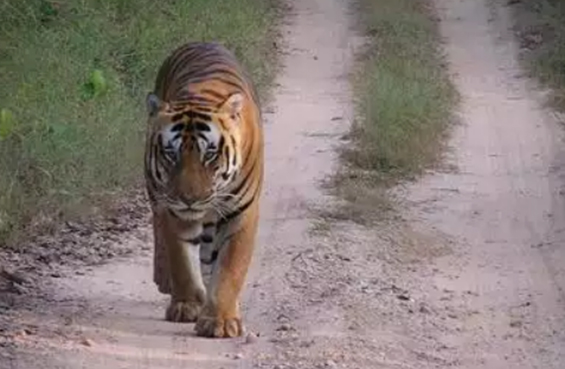 Printed from NAGPUR: Even as Global Tiger Day (GTD) is
celebrated on July 29, Maharashtra has overcome many challenges in tiger
conservation in last 10 years, and left with a few critical ones, which will
be the deciding factor in coming years.
Printed from NAGPUR: Even as Global Tiger Day (GTD) is
celebrated on July 29, Maharashtra has overcome many challenges in tiger
conservation in last 10 years, and left with a few critical ones, which will
be the deciding factor in coming years.
Talking on the eve of GTD on various issues related to tiger conservation,
Kishor Rithe, chief of Satpuda Foundation, and former member of Standing
Committee of National Board for Wildlife (NBWL), said village relocation,
zero tolerance on poaching and wildlife trade, staff recruitment, and
placing efficient officers in wildlife reserves are some of reasons behind
increasing tiger population in Maharashtra.
On the tiger trail, India's women unveil and roar ahead
by Thomson Reuters Foundation | Thomson Reuters Foundation
Friday, 8 March | 2019 00:00 GMT
By Annie Banerji
Printed from NAGPUR: TURIYA, India, March 8 (Thomson Reuters
Foundation) - B obbing along a dirt track in a central Indian tiger reserve,
Varsha Hinge surveyed the landscape for pawprints and listened out for deer
calls warning of tigers before holding up a finger for silence - as a
tigress appeared in front of her jeep.Hinge is one of 10 women safari guides
at the Pench Tiger Reserve who are earning their stripes through long days
helping tourists catch a glimpse of tigers, leopards and wolves.
From entrepreneurs to restaurateurs, dozens of women living near the
national park are breaking with tradition in Madhya Pradesh, where village
women veil themselves in front of men and are usually confined to their
homes as mothers and homemakers.
"In the beginning, I was very hesitant and I doubted myself, thinking I
wouldn't be able to do this, " said Hinge, ahead of International Women's
Day on Friday."I live in a village with my in-laws and (initially) I just
couldn't get comfortable with the idea of wearing pants and shirts in front
of them, " the mother-of-two told the Thomson Reuters Foundation.
The journey has not been easy for these women. Girls in Madhya Pradesh often drop out of school young and wed soon after to live a restricted life bound by age-old customs.The female guides are helping to upend sexist views in India, which has one of the fastest growing major economies globally but startlingly few female employees, in large part due to prejudice against working women.
Only about one in four women work in India - home to 1.3 billion people - which is a lower rate than in most countries, according to the World Bank.With no prior work experience and homes full of children and in-laws, the women had to overcome not only their own anxieties but also stiff opposition at home and in their new workplace.
Hinge said it took a lot of coaxing to get her husband's support.
"I realised that as a homemaker, I would be limited to the four walls of my house and wouldn't grow or contribute anything to my family, " she said. "So, I decided to convince everyone and go for the job."
EVIL EYE
Forsaking their traditional saris and kurta tunics, the national park's first 10 female guides underwent months of training in spotting big cats to prepare for their unusual jobs, where they spend hours cooped up in jeeps with strangers. "Before this, I didn't even know how to interact with people properly ... or know what the word for 'tree' or 'bird' was in English, " said safari guide Sunanda Kawal, 24. "But after joining, I've seen a great improvement in myself. I've gained a lot of knowledge and my fears have started to fade away." As a series of safari jeeps lined up to enter the park, one male guide advised a tourist to stick with the men "if you really want the best experience", saying his women counterparts were not as qualified. The women guides said such comments were common. Most of the 50-odd male guides remain bitter, three years after the women joined their ranks, saying they are not up to the job and are taking their share of safari rides and pay, the women said. Guides can earn up to 12, 000 rupees ($170) a month - far exceeding the average for a rural Indian household. "The male guides didn't want us to work here at all. Even now, they keep to themselves and talk to each other, but not us, " said Kawal, adding that her male colleagues accuse the women of "casting an evil eye" on the park. Hinge's husband Pradeep Kumar, also a safari guide, said he was ostracised by his workmates for supporting his wife. Yet he believes female safari guides have something new to offer - to their communities and customers. "We have seen a change in the women since they got these jobs. It allows them to earn money and that automatically makes a difference at home and within the family, " said Kumar. "Plus, there are always some women guests who come here and say, 'We want a woman guide, not a man'. That way it is a win-win."
CHANGE
While male guides may still be icy, the women say villagers have started
warming up to them after noticing the extra money they bring home, with many
now supportive of their girls working outside the home. That was one of the
main goals for the Satpuda Foundation, which helps women to make and sell
everything from pickles to takeaway meals as part of its community-based
conservation work in the area - one of the world's largest tiger landscapes.
"We have seen a change in attitude of locals, " said Kishor Rithe, the
charity's founder. "The tiger definitely plays an important role in the
women's economic development."
Studies show that women who have financial control invest more in their
children's education, healthcare, businesses and communities, which can be a
step out of poverty.
One of the Satpuda Foundation's latest initiatives is the Mowgli Restaurant
- a small, dimly lit roadside eatery named after the boy in Rudyard
Kipling's childhood classic "The Jungle Book", which is believed to have
been inspired by Pench.
Collectively owned and run by eight village women, the venture has made
nearly 40, 000 rupees since opening in December, serving rice, dals, curries
and snacks to a growing number of customers on their way to and from the
park.
Sandhya Daherwal heads a local women's group which helped to set up the
restaurant and other small businesses that have given about 100 women their
own source of income since 2015.
"I wanted to do something with my life and I wasn't going to let some
naysayers stop me, " she said.
"Success speaks for itself. When you do well, your respect in society
automatically rises. And thanks to the tigers here, that is happening."
($1 = 70.7520 Indian rupees) (Reporting by Annie Banerji @anniebanerji,
Editing by Katy Migiro; Please credit the Thomson Reuters Foundation, the
charitable arm of Thomson Reuters that covers humanitarian issues,
conflicts, land and property rights, modern slavery and human trafficking,
gender equality, climate change and resilience.
Wildlife passes on Gosi canal prove to be a boon
TNN
Mar 15, 2019 | 04.50 IST
Printed from NAGPUR: A young tiger crossing one of the
overpasses of Gosikhurd canal in Halda in Brahmapuri proves why mitigation
measures for linear projects are necessary.
Forest sources claimed it was the same two-year-old tigress that had mauled
two persons and injured eight in Halda, Murpar, Dorli, Awalgaon, Vandra,
Chichgaon and Padmapur villages in South Brahmapuri range. It was captured
on March 4 and sent to Gorewada Rescue Centre at Nagpur.
However, state's chief wildlife warden Nitin H Kakodkar said, "I'm not sure.
We will have to confirm from the stripe pattern whether it is the same
tigress."
The picture of tigress crossing the overpass was captured by wildlife
photographer Mayank Mishra, also one of the contractors and for the project.
"I could capture picture of the young tigress 15 days ago during the day. In
search of new territory, the tigress was frequently sighted by labourers at
work even during the day. There was scare among the people, " Mishra
said.
AR Kamble, chief engineer of Gosikhurd irrigation project, told TOI,
"Constructing overpasses is one of the conditions to get forest clearance.
At some locations we have passed canal through reinforced cement concrete
(RCC) conduit and then canal ground level is restored by backfilling."
"This is one of the methods for creating wildlife passes. It looks like
natural habitat for tigers and it is good that big cats are using them. We
will construct 24 such passes on the canal by June this year. The right bank
canal (RBC) is 99-km-long, " Kamble added.
The Gosikhurd RBC passes through dense forest areas. It is an express canal
directly connected to dam at Paoni. Last year, dominant tiger of
Umred-Karhandla Wildlife Sanctuary Jaichand had slipped in the main canal
due to absence of mitigation steps.
Forest officials admit around 50 incidents of animals falling into canal had
occurred in last 3 years and chitals, sambars, bisons and wild boars had
been rescued in them. The incidents are occurring frequently as few wildlife
crossings have been made despite a state-level committee recommending
them.
Tigress Kala had got stuck in a Gosikhurd sub-canal in Bhiwapur on November
24, 2011. State wildlife board member Kishor Rithe had raised the issue of
mitigation measures over canals in Bhandara and Chandrapur districts in the
board meeting on June 7, 2012. Taking note of it, state formed a committee
on June 23, 2014, under then Pench field director MS Reddy with irrigation
officials, activist Poonam Dhanwatey and Bandu Dhotre as members.
Tribals will not be homeless even if evicted for illegal forest occupation under FRA: Activists
TNN
Feb 23, 2019 | 06.21 AM IST
Printed from NAGPUR: Greens and even activists working under Forest (Rights) Act have said that tribals will not become homeless as feared and that "there is no need to panic". Some tribal rights activists and organizations had claimed that lakhs of tribals will be evicted post a Supreme Court order on February 13. Coming down heavily on bogus claims under the Forest (Rights) Act, 2006, the SC, directed 17 states to furnish data on eviction against rejected claims under FRA which caused panic. Of the 42 lakh title claims, 19, 34, 345 stood rejected as on September 30, 2018 as per ministry of tribal affairs (MoTA). This includes 18, 88, 066 individual claims. Kishore Rithe, who is a member of the state wildlife board, said that nobody will be homeless and landless if eviction does take place. "Most of the claimants are already land holders and they have extended their agriculture fields in the forest. These are the illegal encroachments which if removed will not make tribals landless as they would still possess legal land title as well as a house in the village, " he said. One of petitioners, Praveen Bhargav of Wildlife First of Bengaluru, said, "The SC ruling is misconstrued. Of the total rejected claims, over 14.70 lakh were done at the gram sabha level, which is considered as the powerful decision-making body at grass roots. FRA deals with pre-existing rights and it's not a land distributing law." However, senior FRA activist Mohan Hirabai Hiralal says the SC is not clear about rejected claims. "I agree that after cut-off date of December 13, 2005 or bogus claims should not be allowed. FRA also has provision of granting 90 days for the claimants to argue cases." He added, "There will be unrest if eviction without following the proper rejection titles is not followed. Satellite imagery will be the best evidence, which SC has asked Forest Survey of India (FSI) to do." Promoters of FRA - Forest Rights Alliance and Bhumi Adhikar Andolan - criticized the NDA government for non-effective implementation of the Act. In a release, CPM leader Brinda Karat demanded that an ordinance be issued to protest rights of forest dwellers. However, Dr Nishikant Kale, president of Amravati's Nature Conservation Society which is also a petitioner in the case, says, "Most of the tribal villages situated in forest landscapes have 60% households which are landless. If the government wants to give away forest land, the country's entire forests will not be enough to meet the requirement." "The landless forest dwelling families entirely depend on forest areas surrounding their villages for grazing, fuelwood and forest produce collection. If these lands are distributed to few claimants, a large section of tribal communities will be affected, " said environmental activist Bittu Sahgal. "In Jalgaon and Nashik districts, after a long march by tribal/non-tribal farmers, a huge number of rejected claims were reconsidered and granted, " said Raju Nannaware of Satpuda Bachav Kruti Samiti, Jalgaon. Dilip Gode of Vidarbha Nature Conservation Society (VNCS), who works in 450 villages in Vidarbha to protect community forest rights (CFRs), sees no problem in the SC order. "Encroachments on forest land under the garb of 'patas' should be freed immediately. The order is not against tribals and those who feel injustice has been done should make their representation before MoTA, " he said.
Higher officials from forest including Mr. M. S. Reddy (APCCF & Field Director Melghat Tiger Reserve), Shri Vishal Mali- DFO Melghat Tiger Reserve and other staff rushed to the spot to take stock of the situation.
Incident on 22nd January 2019 at Kelpani area of Akot Division of Melghat Tiger Reserve.
Nagpur
22.01.2019
On 14th January 2019 around 300- 500 residents of rehabilitated villages of Akot division instigated by some local leaders and miscreants had entered the Melghat Tiger Reserve and occupied the meadows illegally.
On 22nd January 2019 at 3:00pm around hundred police staff and equal number
of forest staff approached the villagers who were sitting at Kelpani to talk
with them and forward their issues to the higher authorities. The local
authorities had taken busses to coax the villagers, who were 200- 300 in
numbers, out of the forest which they were illegally occupying. During the
talks the villagers became violent and started pelting stones at the police
and forest staff. Many of them came rushing at the forest staff with axe,
slings, sticks, chilli powder and stones. In the ensuing melee over 50
forest staff and 15 police staff were seriously injured. Some of the staff
received serious laceration injuries to their bodies, backs, arms and heads.
RFO of Dhargad Mr. Sunil Wakode was also seriously injured with the
villagers using an axe to attack him and his forester Mr. Ingole. Till the
time of sending this report the seriously injured forest staff were on their
way to hospitals in Akola and Amravati for treatment.
In the attack by villagers over 15 vehicles of the government including that
of DCF Akot Mrs. T. Beula, Police Inspector Akot, etc. were damaged. The
attackers ran away from the spot after this deadly attack and the forest and
police staff could nab 2 to 3 people. While running away the villagers set
fire to the entire meadows of that division. It is learnt that a huge area
of mleghat Tiger Reserve which is core and prime habitat of tiger has been
burnt down by these miscreants and villagers. No village person was injured
in this exchange as police lobbed tear gas to disperse the attacking mob.
Post this section 144 was imposed on this area.
Higher officials from forest including Mr. M. S. Reddy (APCCF & Field Director Melghat Tiger Reserve), Shri Vishal Mali- DFO Melghat Tiger Reserve and other staff rushed to the spot to take stock of the situation.
